
worker-vllm
The RunPod worker template for serving our large language model endpoints. Powered by vLLM.
Stars: 300
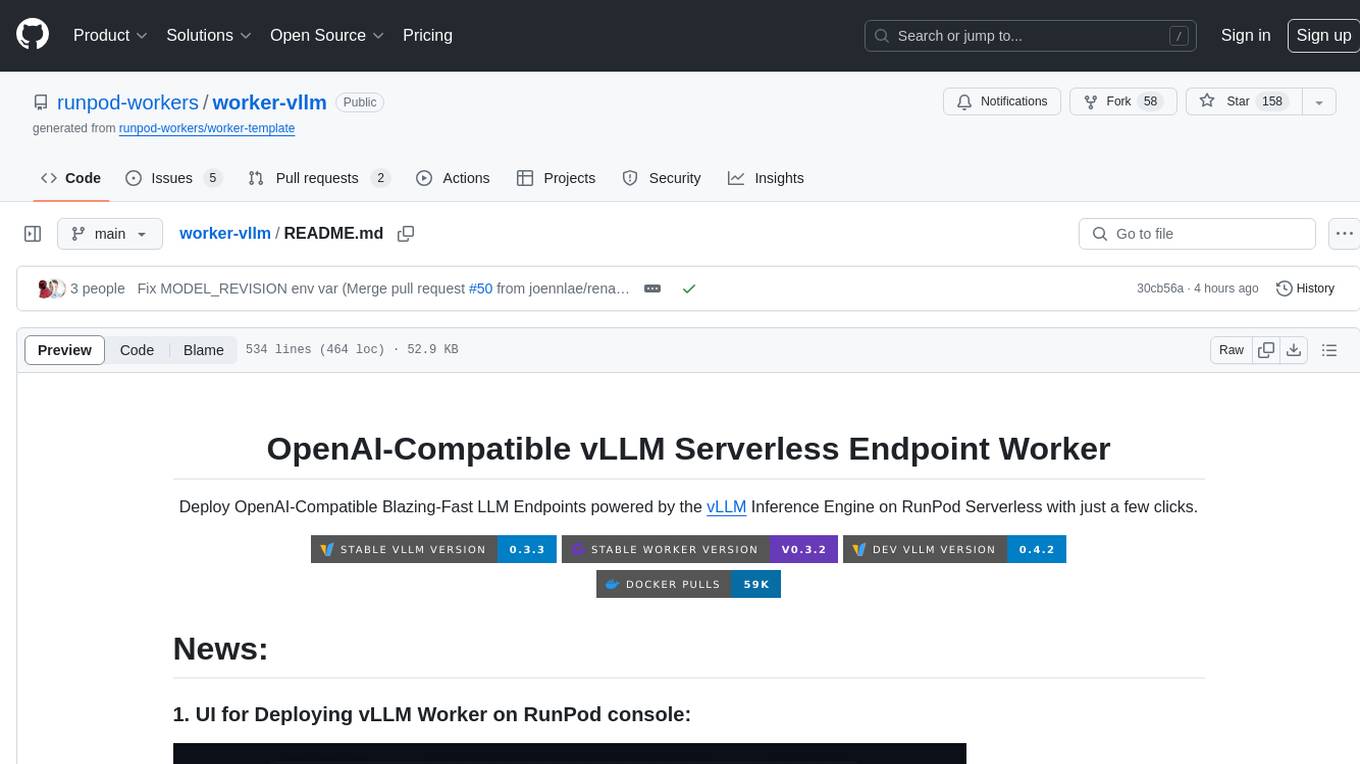
The worker-vLLM repository provides a serverless endpoint for deploying OpenAI-compatible vLLM models with blazing-fast performance. It supports deploying various model architectures, such as Aquila, Baichuan, BLOOM, ChatGLM, Command-R, DBRX, DeciLM, Falcon, Gemma, GPT-2, GPT BigCode, GPT-J, GPT-NeoX, InternLM, Jais, LLaMA, MiniCPM, Mistral, Mixtral, MPT, OLMo, OPT, Orion, Phi, Phi-3, Qwen, Qwen2, Qwen2MoE, StableLM, Starcoder2, Xverse, and Yi. Users can deploy models using pre-built Docker images or build custom images with specified arguments. The repository also supports OpenAI compatibility for chat completions, completions, and models, with customizable input parameters. Users can modify their OpenAI codebase to use the deployed vLLM worker and access a list of available models for deployment.
README:
Deploy OpenAI-Compatible Blazing-Fast LLM Endpoints powered by the vLLM Inference Engine on RunPod Serverless with just a few clicks.
Update v2.2.0 is now available, use the image tag runpod/worker-v1-vllm:v2.2.0stable-cuda12.1.0.
3. OpenAI-Compatible Embedding Worker Released
Deploy your own OpenAI-compatible Serverless Endpoint on RunPod with multiple embedding models and fast inference for RAG and more!
Worker vLLM is now cached on all RunPod machines, resulting in near-instant deployment! Previously, downloading and extracting the image took 3-5 minutes on average.
- Setting up the Serverless Worker
- Usage: OpenAI Compatibility
- Usage: standard
- Worker Config
[!NOTE] You can now deploy from the dedicated UI on the RunPod console with all of the settings and choices listed. Try now by accessing in Explore or Serverless pages on the RunPod console!
We now offer a pre-built Docker Image for the vLLM Worker that you can configure entirely with Environment Variables when creating the RunPod Serverless Endpoint:
Below is a summary of the available RunPod Worker images, categorized by image stability and CUDA version compatibility.
| CUDA Version | Stable Image Tag | Development Image Tag | Note |
|---|---|---|---|
| 12.1.0 | runpod/worker-v1-vllm:v2.2.0stable-cuda12.1.0 |
runpod/worker-v1-vllm:v2.2.0dev-cuda12.1.0 |
When creating an Endpoint, select CUDA Version 12.3, 12.2 and 12.1 in the filter. |
- RunPod Account
Note:
0is equivalent toFalseand1is equivalent toTruefor boolean as int values.
Name |
Default |
Type/Choices |
Description |
|---|---|---|---|
MODEL_NAME |
'facebook/opt-125m' | str |
Name or path of the Hugging Face model to use. |
TOKENIZER |
None | str |
Name or path of the Hugging Face tokenizer to use. |
SKIP_TOKENIZER_INIT |
False | bool |
Skip initialization of tokenizer and detokenizer. |
TOKENIZER_MODE |
'auto' | ['auto', 'slow'] | The tokenizer mode. |
TRUST_REMOTE_CODE |
False |
bool |
Trust remote code from Hugging Face. |
DOWNLOAD_DIR |
None | str |
Directory to download and load the weights. |
LOAD_FORMAT |
'auto' | str |
The format of the model weights to load. |
HF_TOKEN |
- | str |
Hugging Face token for private and gated models. |
DTYPE |
'auto' | ['auto', 'half', 'float16', 'bfloat16', 'float', 'float32'] | Data type for model weights and activations. |
KV_CACHE_DTYPE |
'auto' | ['auto', 'fp8'] | Data type for KV cache storage. |
QUANTIZATION_PARAM_PATH |
None | str |
Path to the JSON file containing the KV cache scaling factors. |
MAX_MODEL_LEN |
None | int |
Model context length. |
GUIDED_DECODING_BACKEND |
'outlines' | ['outlines', 'lm-format-enforcer'] | Which engine will be used for guided decoding by default. |
DISTRIBUTED_EXECUTOR_BACKEND |
None | ['ray', 'mp'] | Backend to use for distributed serving. |
WORKER_USE_RAY |
False | bool |
Deprecated, use --distributed-executor-backend=ray. |
PIPELINE_PARALLEL_SIZE |
1 | int |
Number of pipeline stages. |
TENSOR_PARALLEL_SIZE |
1 | int |
Number of tensor parallel replicas. |
MAX_PARALLEL_LOADING_WORKERS |
None | int |
Load model sequentially in multiple batches. |
RAY_WORKERS_USE_NSIGHT |
False | bool |
If specified, use nsight to profile Ray workers. |
ENABLE_PREFIX_CACHING |
False | bool |
Enables automatic prefix caching. |
DISABLE_SLIDING_WINDOW |
False | bool |
Disables sliding window, capping to sliding window size. |
USE_V2_BLOCK_MANAGER |
False | bool |
Use BlockSpaceMangerV2. |
NUM_LOOKAHEAD_SLOTS |
0 | int |
Experimental scheduling config necessary for speculative decoding. |
SEED |
0 | int |
Random seed for operations. |
NUM_GPU_BLOCKS_OVERRIDE |
None | int |
If specified, ignore GPU profiling result and use this number of GPU blocks. |
MAX_NUM_BATCHED_TOKENS |
None | int |
Maximum number of batched tokens per iteration. |
MAX_NUM_SEQS |
256 | int |
Maximum number of sequences per iteration. |
MAX_LOGPROBS |
20 | int |
Max number of log probs to return when logprobs is specified in SamplingParams. |
DISABLE_LOG_STATS |
False | bool |
Disable logging statistics. |
QUANTIZATION |
None | ['awq', 'squeezellm', 'gptq'] | Method used to quantize the weights. |
ROPE_SCALING |
None | dict |
RoPE scaling configuration in JSON format. |
ROPE_THETA |
None | float |
RoPE theta. Use with rope_scaling. |
TOKENIZER_POOL_SIZE |
0 | int |
Size of tokenizer pool to use for asynchronous tokenization. |
TOKENIZER_POOL_TYPE |
'ray' | str |
Type of tokenizer pool to use for asynchronous tokenization. |
TOKENIZER_POOL_EXTRA_CONFIG |
None | dict |
Extra config for tokenizer pool. |
ENABLE_LORA |
False | bool |
If True, enable handling of LoRA adapters. |
MAX_LORAS |
1 | int |
Max number of LoRAs in a single batch. |
MAX_LORA_RANK |
16 | int |
Max LoRA rank. |
LORA_EXTRA_VOCAB_SIZE |
256 | int |
Maximum size of extra vocabulary for LoRA adapters. |
LORA_DTYPE |
'auto' | ['auto', 'float16', 'bfloat16', 'float32'] | Data type for LoRA. |
LONG_LORA_SCALING_FACTORS |
None | tuple |
Specify multiple scaling factors for LoRA adapters. |
MAX_CPU_LORAS |
None | int |
Maximum number of LoRAs to store in CPU memory. |
FULLY_SHARDED_LORAS |
False | bool |
Enable fully sharded LoRA layers. |
SCHEDULER_DELAY_FACTOR |
0.0 | float |
Apply a delay before scheduling next prompt. |
ENABLE_CHUNKED_PREFILL |
False | bool |
Enable chunked prefill requests. |
SPECULATIVE_MODEL |
None | str |
The name of the draft model to be used in speculative decoding. |
NUM_SPECULATIVE_TOKENS |
None | int |
The number of speculative tokens to sample from the draft model. |
SPECULATIVE_DRAFT_TENSOR_PARALLEL_SIZE |
None | int |
Number of tensor parallel replicas for the draft model. |
SPECULATIVE_MAX_MODEL_LEN |
None | int |
The maximum sequence length supported by the draft model. |
SPECULATIVE_DISABLE_BY_BATCH_SIZE |
None | int |
Disable speculative decoding if the number of enqueue requests is larger than this value. |
NGRAM_PROMPT_LOOKUP_MAX |
None | int |
Max size of window for ngram prompt lookup in speculative decoding. |
NGRAM_PROMPT_LOOKUP_MIN |
None | int |
Min size of window for ngram prompt lookup in speculative decoding. |
SPEC_DECODING_ACCEPTANCE_METHOD |
'rejection_sampler' | ['rejection_sampler', 'typical_acceptance_sampler'] | Specify the acceptance method for draft token verification in speculative decoding. |
TYPICAL_ACCEPTANCE_SAMPLER_POSTERIOR_THRESHOLD |
None | float |
Set the lower bound threshold for the posterior probability of a token to be accepted. |
TYPICAL_ACCEPTANCE_SAMPLER_POSTERIOR_ALPHA |
None | float |
A scaling factor for the entropy-based threshold for token acceptance. |
MODEL_LOADER_EXTRA_CONFIG |
None | dict |
Extra config for model loader. |
PREEMPTION_MODE |
None | str |
If 'recompute', the engine performs preemption-aware recomputation. If 'save', the engine saves activations into the CPU memory as preemption happens. |
PREEMPTION_CHECK_PERIOD |
1.0 | float |
How frequently the engine checks if a preemption happens. |
PREEMPTION_CPU_CAPACITY |
2 | float |
The percentage of CPU memory used for the saved activations. |
DISABLE_LOGGING_REQUEST |
False | bool |
Disable logging requests. |
MAX_LOG_LEN |
None | int |
Max number of prompt characters or prompt ID numbers being printed in log. |
| Tokenizer Settings | |||
TOKENIZER_NAME |
None |
str |
Tokenizer repository to use a different tokenizer than the model's default. |
TOKENIZER_REVISION |
None |
str |
Tokenizer revision to load. |
CUSTOM_CHAT_TEMPLATE |
None |
str of single-line jinja template |
Custom chat jinja template. More Info |
| System, GPU, and Tensor Parallelism(Multi-GPU) Settings | |||
GPU_MEMORY_UTILIZATION |
0.95 |
float |
Sets GPU VRAM utilization. |
MAX_PARALLEL_LOADING_WORKERS |
None |
int |
Load model sequentially in multiple batches, to avoid RAM OOM when using tensor parallel and large models. |
BLOCK_SIZE |
16 |
8, 16, 32
|
Token block size for contiguous chunks of tokens. |
SWAP_SPACE |
4 |
int |
CPU swap space size (GiB) per GPU. |
ENFORCE_EAGER |
False | bool |
Always use eager-mode PyTorch. If False(0), will use eager mode and CUDA graph in hybrid for maximal performance and flexibility. |
MAX_SEQ_LEN_TO_CAPTURE |
8192 |
int |
Maximum context length covered by CUDA graphs. When a sequence has context length larger than this, we fall back to eager mode. |
DISABLE_CUSTOM_ALL_REDUCE |
0 |
int |
Enables or disables custom all reduce. |
| Streaming Batch Size Settings: | |||
DEFAULT_BATCH_SIZE |
50 |
int |
Default and Maximum batch size for token streaming to reduce HTTP calls. |
DEFAULT_MIN_BATCH_SIZE |
1 |
int |
Batch size for the first request, which will be multiplied by the growth factor every subsequent request. |
DEFAULT_BATCH_SIZE_GROWTH_FACTOR |
3 |
float |
Growth factor for dynamic batch size. |
The way this works is that the first request will have a batch size of DEFAULT_MIN_BATCH_SIZE, and each subsequent request will have a batch size of previous_batch_size * DEFAULT_BATCH_SIZE_GROWTH_FACTOR. This will continue until the batch size reaches DEFAULT_BATCH_SIZE. E.g. for the default values, the batch sizes will be 1, 3, 9, 27, 50, 50, 50, .... You can also specify this per request, with inputs max_batch_size, min_batch_size, and batch_size_growth_factor. This has nothing to do with vLLM's internal batching, but rather the number of tokens sent in each HTTP request from the worker |
|||
| OpenAI Settings | |||
RAW_OPENAI_OUTPUT |
1 |
boolean as int
|
Enables raw OpenAI SSE format string output when streaming. Required to be enabled (which it is by default) for OpenAI compatibility. |
OPENAI_SERVED_MODEL_NAME_OVERRIDE |
None |
str |
Overrides the name of the served model from model repo/path to specified name, which you will then be able to use the value for the model parameter when making OpenAI requests |
OPENAI_RESPONSE_ROLE |
assistant |
str |
Role of the LLM's Response in OpenAI Chat Completions. |
| Serverless Settings | |||
MAX_CONCURRENCY |
300 |
int |
Max concurrent requests per worker. vLLM has an internal queue, so you don't have to worry about limiting by VRAM, this is for improving scaling/load balancing efficiency |
DISABLE_LOG_STATS |
False | bool |
Enables or disables vLLM stats logging. |
DISABLE_LOG_REQUESTS |
False | bool |
Enables or disables vLLM request logging. |
[!TIP] If you are facing issues when using Mixtral 8x7B, Quantized models, or handling unusual models/architectures, try setting
TRUST_REMOTE_CODEto1.
To build an image with the model baked in, you must specify the following docker arguments when building the image.
- RunPod Account
- Docker
-
Required
MODEL_NAME
-
Optional
-
MODEL_REVISION: Model revision to load (default:main). -
BASE_PATH: Storage directory where huggingface cache and model will be located. (default:/runpod-volume, which will utilize network storage if you attach it or create a local directory within the image if you don't. If your intention is to bake the model into the image, you should set this to something like/modelsto make sure there are no issues if you were to accidentally attach network storage.) QUANTIZATION-
WORKER_CUDA_VERSION:12.1.0(12.1.0is recommended for optimal performance). -
TOKENIZER_NAME: Tokenizer repository if you would like to use a different tokenizer than the one that comes with the model. (default:None, which uses the model's tokenizer) -
TOKENIZER_REVISION: Tokenizer revision to load (default:main).
-
For the remaining settings, you may apply them as environment variables when running the container. Supported environment variables are listed in the Environment Variables section.
sudo docker build -t username/image:tag --build-arg MODEL_NAME="openchat/openchat_3.5" --build-arg BASE_PATH="/models" .If the model you would like to deploy is private or gated, you will need to include it during build time as a Docker secret, which will protect it from being exposed in the image and on DockerHub.
- Enable Docker BuildKit (required for secrets).
export DOCKER_BUILDKIT=1- Export your Hugging Face token as an environment variable
export HF_TOKEN="your_token_here"- Add the token as a secret when building
docker build -t username/image:tag --secret id=HF_TOKEN --build-arg MODEL_NAME="openchat/openchat_3.5" .Below are all supported model architectures (and examples of each) that you can deploy using the vLLM Worker. You can deploy any model on HuggingFace, as long as its base architecture is one of the following:
- Aquila & Aquila2 (
BAAI/AquilaChat2-7B,BAAI/AquilaChat2-34B,BAAI/Aquila-7B,BAAI/AquilaChat-7B, etc.) - Baichuan & Baichuan2 (
baichuan-inc/Baichuan2-13B-Chat,baichuan-inc/Baichuan-7B, etc.) - BLOOM (
bigscience/bloom,bigscience/bloomz, etc.) - ChatGLM (
THUDM/chatglm2-6b,THUDM/chatglm3-6b, etc.) - Command-R (
CohereForAI/c4ai-command-r-v01, etc.) - DBRX (
databricks/dbrx-base,databricks/dbrx-instructetc.) - DeciLM (
Deci/DeciLM-7B,Deci/DeciLM-7B-instruct, etc.) - Falcon (
tiiuae/falcon-7b,tiiuae/falcon-40b,tiiuae/falcon-rw-7b, etc.) - Gemma (
google/gemma-2b,google/gemma-7b, etc.) - GPT-2 (
gpt2,gpt2-xl, etc.) - GPT BigCode (
bigcode/starcoder,bigcode/gpt_bigcode-santacoder, etc.) - GPT-J (
EleutherAI/gpt-j-6b,nomic-ai/gpt4all-j, etc.) - GPT-NeoX (
EleutherAI/gpt-neox-20b,databricks/dolly-v2-12b,stabilityai/stablelm-tuned-alpha-7b, etc.) - InternLM (
internlm/internlm-7b,internlm/internlm-chat-7b, etc.) - InternLM2 (
internlm/internlm2-7b,internlm/internlm2-chat-7b, etc.) - Jais (
core42/jais-13b,core42/jais-13b-chat,core42/jais-30b-v3,core42/jais-30b-chat-v3, etc.) - LLaMA, Llama 2, and Meta Llama 3 (
meta-llama/Meta-Llama-3-8B-Instruct,meta-llama/Meta-Llama-3-70B-Instruct,meta-llama/Llama-2-70b-hf,lmsys/vicuna-13b-v1.3,young-geng/koala,openlm-research/open_llama_13b, etc.) - MiniCPM (
openbmb/MiniCPM-2B-sft-bf16,openbmb/MiniCPM-2B-dpo-bf16, etc.) - Mistral (
mistralai/Mistral-7B-v0.1,mistralai/Mistral-7B-Instruct-v0.1, etc.) - Mixtral (
mistralai/Mixtral-8x7B-v0.1,mistralai/Mixtral-8x7B-Instruct-v0.1,mistral-community/Mixtral-8x22B-v0.1, etc.) - MPT (
mosaicml/mpt-7b,mosaicml/mpt-30b, etc.) - OLMo (
allenai/OLMo-1B-hf,allenai/OLMo-7B-hf, etc.) - OPT (
facebook/opt-66b,facebook/opt-iml-max-30b, etc.) - Orion (
OrionStarAI/Orion-14B-Base,OrionStarAI/Orion-14B-Chat, etc.) - Phi (
microsoft/phi-1_5,microsoft/phi-2, etc.) - Phi-3 (
microsoft/Phi-3-mini-4k-instruct,microsoft/Phi-3-mini-128k-instruct, etc.) - Qwen (
Qwen/Qwen-7B,Qwen/Qwen-7B-Chat, etc.) - Qwen2 (
Qwen/Qwen1.5-7B,Qwen/Qwen1.5-7B-Chat, etc.) - Qwen2MoE (
Qwen/Qwen1.5-MoE-A2.7B,Qwen/Qwen1.5-MoE-A2.7B-Chat, etc.) - StableLM(
stabilityai/stablelm-3b-4e1t,stabilityai/stablelm-base-alpha-7b-v2, etc.) - Starcoder2(
bigcode/starcoder2-3b,bigcode/starcoder2-7b,bigcode/starcoder2-15b, etc.) - Xverse (
xverse/XVERSE-7B-Chat,xverse/XVERSE-13B-Chat,xverse/XVERSE-65B-Chat, etc.) - Yi (
01-ai/Yi-6B,01-ai/Yi-34B, etc.)
The vLLM Worker is fully compatible with OpenAI's API, and you can use it with any OpenAI Codebase by changing only 3 lines in total. The supported routes are Chat Completions and Models - with both streaming and non-streaming.
Python (similar to Node.js, etc.):
-
When initializing the OpenAI Client in your code, change the
api_keyto your RunPod API Key and thebase_urlto your RunPod Serverless Endpoint URL in the following format:https://api.runpod.ai/v2/<YOUR ENDPOINT ID>/openai/v1, filling in your deployed endpoint ID. For example, if your Endpoint ID isabc1234, the URL would behttps://api.runpod.ai/v2/abc1234/openai/v1.- Before:
from openai import OpenAI client = OpenAI(api_key=os.environ.get("OPENAI_API_KEY"))
- After:
from openai import OpenAI client = OpenAI( api_key=os.environ.get("RUNPOD_API_KEY"), base_url="https://api.runpod.ai/v2/<YOUR ENDPOINT ID>/openai/v1", )
-
Change the
modelparameter to your deployed model's name whenever using Completions or Chat Completions.- Before:
response = client.chat.completions.create( model="gpt-3.5-turbo", messages=[{"role": "user", "content": "Why is RunPod the best platform?"}], temperature=0, max_tokens=100, )
- After:
response = client.chat.completions.create( model="<YOUR DEPLOYED MODEL REPO/NAME>", messages=[{"role": "user", "content": "Why is RunPod the best platform?"}], temperature=0, max_tokens=100, )
Using http requests:
- Change the
Authorizationheader to your RunPod API Key and theurlto your RunPod Serverless Endpoint URL in the following format:https://api.runpod.ai/v2/<YOUR ENDPOINT ID>/openai/v1- Before:
curl https://api.openai.com/v1/chat/completions \ -H "Content-Type: application/json" \ -H "Authorization: Bearer $OPENAI_API_KEY" \ -d '{ "model": "gpt-4", "messages": [ { "role": "user", "content": "Why is RunPod the best platform?" } ], "temperature": 0, "max_tokens": 100 }'
- After:
curl https://api.runpod.ai/v2/<YOUR ENDPOINT ID>/openai/v1/chat/completions \ -H "Content-Type: application/json" \ -H "Authorization: Bearer <YOUR OPENAI API KEY>" \ -d '{ "model": "<YOUR DEPLOYED MODEL REPO/NAME>", "messages": [ { "role": "user", "content": "Why is RunPod the best platform?" } ], "temperature": 0, "max_tokens": 100 }'
When using the chat completion feature of the vLLM Serverless Endpoint Worker, you can customize your requests with the following parameters:
Supported Chat Completions Inputs and Descriptions
| Parameter | Type | Default Value | Description |
|---|---|---|---|
messages |
Union[str, List[Dict[str, str]]] | List of messages, where each message is a dictionary with a role and content. The model's chat template will be applied to the messages automatically, so the model must have one or it should be specified as CUSTOM_CHAT_TEMPLATE env var. |
|
model |
str | The model repo that you've deployed on your RunPod Serverless Endpoint. If you are unsure what the name is or are baking the model in, use the guide to get the list of available models in the Examples: Using your RunPod endpoint with OpenAI section | |
temperature |
Optional[float] | 0.7 | Float that controls the randomness of the sampling. Lower values make the model more deterministic, while higher values make the model more random. Zero means greedy sampling. |
top_p |
Optional[float] | 1.0 | Float that controls the cumulative probability of the top tokens to consider. Must be in (0, 1]. Set to 1 to consider all tokens. |
n |
Optional[int] | 1 | Number of output sequences to return for the given prompt. |
max_tokens |
Optional[int] | None | Maximum number of tokens to generate per output sequence. |
seed |
Optional[int] | None | Random seed to use for the generation. |
stop |
Optional[Union[str, List[str]]] | list | List of strings that stop the generation when they are generated. The returned output will not contain the stop strings. |
stream |
Optional[bool] | False | Whether to stream or not |
presence_penalty |
Optional[float] | 0.0 | Float that penalizes new tokens based on whether they appear in the generated text so far. Values > 0 encourage the model to use new tokens, while values < 0 encourage the model to repeat tokens. |
frequency_penalty |
Optional[float] | 0.0 | Float that penalizes new tokens based on their frequency in the generated text so far. Values > 0 encourage the model to use new tokens, while values < 0 encourage the model to repeat tokens. |
logit_bias |
Optional[Dict[str, float]] | None | Unsupported by vLLM |
user |
Optional[str] | None | Unsupported by vLLM |
| Additional parameters supported by vLLM: | |||
best_of |
Optional[int] | None | Number of output sequences that are generated from the prompt. From these best_of sequences, the top n sequences are returned. best_of must be greater than or equal to n. This is treated as the beam width when use_beam_search is True. By default, best_of is set to n. |
top_k |
Optional[int] | -1 | Integer that controls the number of top tokens to consider. Set to -1 to consider all tokens. |
ignore_eos |
Optional[bool] | False | Whether to ignore the EOS token and continue generating tokens after the EOS token is generated. |
use_beam_search |
Optional[bool] | False | Whether to use beam search instead of sampling. |
stop_token_ids |
Optional[List[int]] | list | List of tokens that stop the generation when they are generated. The returned output will contain the stop tokens unless the stop tokens are special tokens. |
skip_special_tokens |
Optional[bool] | True | Whether to skip special tokens in the output. |
spaces_between_special_tokens |
Optional[bool] | True | Whether to add spaces between special tokens in the output. Defaults to True. |
add_generation_prompt |
Optional[bool] | True | Read more here |
echo |
Optional[bool] | False | Echo back the prompt in addition to the completion |
repetition_penalty |
Optional[float] | 1.0 | Float that penalizes new tokens based on whether they appear in the prompt and the generated text so far. Values > 1 encourage the model to use new tokens, while values < 1 encourage the model to repeat tokens. |
min_p |
Optional[float] | 0.0 | Float that represents the minimum probability for a token to |
length_penalty |
Optional[float] | 1.0 | Float that penalizes sequences based on their length. Used in beam search.. |
include_stop_str_in_output |
Optional[bool] | False | Whether to include the stop strings in output text. Defaults to False. |
First, initialize the OpenAI Client with your RunPod API Key and Endpoint URL:
from openai import OpenAI
import os
# Initialize the OpenAI Client with your RunPod API Key and Endpoint URL
client = OpenAI(
api_key=os.environ.get("RUNPOD_API_KEY"),
base_url="https://api.runpod.ai/v2/<YOUR ENDPOINT ID>/openai/v1",
)This is the format used for GPT-4 and focused on instruction-following and chat. Examples of Open Source chat/instruct models include meta-llama/Llama-2-7b-chat-hf, mistralai/Mixtral-8x7B-Instruct-v0.1, openchat/openchat-3.5-0106, NousResearch/Nous-Hermes-2-Mistral-7B-DPO and more. However, if your model is a completion-style model with no chat/instruct fine-tune and/or does not have a chat template, you can still use this if you provide a chat template with the environment variable CUSTOM_CHAT_TEMPLATE.
-
Streaming:
# Create a chat completion stream response_stream = client.chat.completions.create( model="<YOUR DEPLOYED MODEL REPO/NAME>", messages=[{"role": "user", "content": "Why is RunPod the best platform?"}], temperature=0, max_tokens=100, stream=True, ) # Stream the response for response in response_stream: print(chunk.choices[0].delta.content or "", end="", flush=True)
-
Non-Streaming:
# Create a chat completion response = client.chat.completions.create( model="<YOUR DEPLOYED MODEL REPO/NAME>", messages=[{"role": "user", "content": "Why is RunPod the best platform?"}], temperature=0, max_tokens=100, ) # Print the response print(response.choices[0].message.content)
In the case of baking the model into the image, sometimes the repo may not be accepted as the model in the request. In this case, you can list the available models as shown below and use that name.
models_response = client.models.list()
list_of_models = [model.id for model in models_response]
print(list_of_models)Click to expand table
You may either use a prompt or a list of messages as input. If you use messages, the model's chat template will be applied to the messages automatically, so the model must have one. If you use prompt, you may optionally apply the model's chat template to the prompt by setting apply_chat_template to true.
| Argument | Type | Default | Description |
|---|---|---|---|
prompt |
str | Prompt string to generate text based on. | |
messages |
list[dict[str, str]] | List of messages, which will automatically have the model's chat template applied. Overrides prompt. |
|
apply_chat_template |
bool | False | Whether to apply the model's chat template to the prompt. |
sampling_params |
dict | {} | Sampling parameters to control the generation, like temperature, top_p, etc. You can find all available parameters in the Sampling Parameters section below. |
stream |
bool | False | Whether to enable streaming of output. If True, responses are streamed as they are generated. |
max_batch_size |
int | env var DEFAULT_BATCH_SIZE
|
The maximum number of tokens to stream every HTTP POST call. |
min_batch_size |
int | env var DEFAULT_MIN_BATCH_SIZE
|
The minimum number of tokens to stream every HTTP POST call. |
batch_size_growth_factor |
int | env var DEFAULT_BATCH_SIZE_GROWTH_FACTOR
|
The growth factor by which min_batch_size will be multiplied for each call until max_batch_size is reached. |
Below are all available sampling parameters that you can specify in the sampling_params dictionary. If you do not specify any of these parameters, the default values will be used.
Click to expand table
| Argument | Type | Default | Description |
|---|---|---|---|
n |
int | 1 | Number of output sequences generated from the prompt. The top n sequences are returned. |
best_of |
Optional[int] | n |
Number of output sequences generated from the prompt. The top n sequences are returned from these best_of sequences. Must be ≥ n. Treated as beam width in beam search. Default is n. |
presence_penalty |
float | 0.0 | Penalizes new tokens based on their presence in the generated text so far. Values > 0 encourage new tokens, values < 0 encourage repetition. |
frequency_penalty |
float | 0.0 | Penalizes new tokens based on their frequency in the generated text so far. Values > 0 encourage new tokens, values < 0 encourage repetition. |
repetition_penalty |
float | 1.0 | Penalizes new tokens based on their appearance in the prompt and generated text. Values > 1 encourage new tokens, values < 1 encourage repetition. |
temperature |
float | 1.0 | Controls the randomness of sampling. Lower values make it more deterministic, higher values make it more random. Zero means greedy sampling. |
top_p |
float | 1.0 | Controls the cumulative probability of top tokens to consider. Must be in (0, 1]. Set to 1 to consider all tokens. |
top_k |
int | -1 | Controls the number of top tokens to consider. Set to -1 to consider all tokens. |
min_p |
float | 0.0 | Represents the minimum probability for a token to be considered, relative to the most likely token. Must be in [0, 1]. Set to 0 to disable. |
use_beam_search |
bool | False | Whether to use beam search instead of sampling. |
length_penalty |
float | 1.0 | Penalizes sequences based on their length. Used in beam search. |
early_stopping |
Union[bool, str] | False | Controls stopping condition in beam search. Can be True, False, or "never". |
stop |
Union[None, str, List[str]] | None | List of strings that stop generation when produced. The output will not contain these strings. |
stop_token_ids |
Optional[List[int]] | None | List of token IDs that stop generation when produced. Output contains these tokens unless they are special tokens. |
ignore_eos |
bool | False | Whether to ignore the End-Of-Sequence token and continue generating tokens after its generation. |
max_tokens |
int | 16 | Maximum number of tokens to generate per output sequence. |
skip_special_tokens |
bool | True | Whether to skip special tokens in the output. |
spaces_between_special_tokens |
bool | True | Whether to add spaces between special tokens in the output. |
You may either use a prompt or a list of messages as input.
-
promptThe prompt string can be any string, and the model's chat template will not be applied to it unlessapply_chat_templateis set totrue, in which case it will be treated as a user message.Example:
{ "input": { "prompt": "why sky is blue?", "sampling_params": { "temperature": 0.7, "max_tokens": 100 } } } -
messagesYour list can contain any number of messages, and each message usually can have any role from the following list:userassistantsystem
However, some models may have different roles, so you should check the model's chat template to see which roles are required.
The model's chat template will be applied to the messages automatically, so the model must have one.
Example:
{ "input": { "messages": [ { "role": "system", "content": "You are a helpful AI assistant that provides clear and concise responses." }, { "role": "user", "content": "Can you explain the difference between supervised and unsupervised learning?" }, { "role": "assistant", "content": "Sure! Supervised learning uses labeled data, meaning each input has a corresponding correct output. The model learns by mapping inputs to known outputs. In contrast, unsupervised learning works with unlabeled data, where the model identifies patterns, structures, or clusters without predefined answers." } ], "sampling_params": { "temperature": 0.7, "max_tokens": 100 } } }
The worker config is a JSON file that is used to build the form that helps users configure their serverless endpoint on the RunPod Web Interface.
Note: This is a new feature and only works for workers that use one model
The JSON consists of two main parts, schema and versions.
-
schema: Here you specify the form fields that will be displayed to the user.-
env_var_name: The name of the environment variable that is being set using the form field. -
value: This is the default value of the form field. It will be shown in the UI as such unless the user changes it. -
title: This is the title of the form field in the UI. -
description: This is the description of the form field in the UI. -
required: This is a boolean that specifies if the form field is required. -
type: This is the type of the form field. Options are:-
text: Environment variable is a string so user inputs text in form field. -
select: User selects one option from the dropdown. You must provide theoptionskey value pair after type if using this. -
toggle: User toggles between true and false. -
number: User inputs a number in the form field.
-
-
options: Specify the options the user can select from if the type isselect. DO NOT include this unless thetypeisselect.
-
-
versions: This is where you call the form fields specified inschemaand organize them into categories.-
imageName: This is the name of the Docker image that will be used to run the serverless endpoint. -
minimumCudaVersion: This is the minimum CUDA version that is required to run the serverless endpoint. -
categories: This is where you call the keys of the form fields specified inschemaand organize them into categories. Each category is a toggle list of forms on the Web UI.-
title: This is the title of the category in the UI. -
settings: This is the array of settings schemas specified inschemaassociated with the category.
-
-
{
"schema": {
"TOKENIZER": {
"env_var_name": "TOKENIZER",
"value": "",
"title": "Tokenizer",
"description": "Name or path of the Hugging Face tokenizer to use.",
"required": false,
"type": "text"
},
"TOKENIZER_MODE": {
"env_var_name": "TOKENIZER_MODE",
"value": "auto",
"title": "Tokenizer Mode",
"description": "The tokenizer mode.",
"required": false,
"type": "select",
"options": [
{ "value": "auto", "label": "auto" },
{ "value": "slow", "label": "slow" }
]
},
...
}
}{
"versions": {
"0.5.4": {
"imageName": "runpod/worker-v1-vllm:v1.2.0stable-cuda12.1.0",
"minimumCudaVersion": "12.1",
"categories": [
{
"title": "LLM Settings",
"settings": [
"TOKENIZER", "TOKENIZER_MODE", "OTHER_SETTINGS_SCHEMA_KEYS_YOU_HAVE_SPECIFIED_0", ...
]
},
{
"title": "Tokenizer Settings",
"settings": [
"OTHER_SETTINGS_SCHEMA_KEYS_0", "OTHER_SETTINGS_SCHEMA_KEYS_1", ...
]
},
...
]
}
}
}For Tasks:
Click tags to check more tools for each tasksFor Jobs:
Alternative AI tools for worker-vllm
Similar Open Source Tools

worker-vllm
The worker-vLLM repository provides a serverless endpoint for deploying OpenAI-compatible vLLM models with blazing-fast performance. It supports deploying various model architectures, such as Aquila, Baichuan, BLOOM, ChatGLM, Command-R, DBRX, DeciLM, Falcon, Gemma, GPT-2, GPT BigCode, GPT-J, GPT-NeoX, InternLM, Jais, LLaMA, MiniCPM, Mistral, Mixtral, MPT, OLMo, OPT, Orion, Phi, Phi-3, Qwen, Qwen2, Qwen2MoE, StableLM, Starcoder2, Xverse, and Yi. Users can deploy models using pre-built Docker images or build custom images with specified arguments. The repository also supports OpenAI compatibility for chat completions, completions, and models, with customizable input parameters. Users can modify their OpenAI codebase to use the deployed vLLM worker and access a list of available models for deployment.
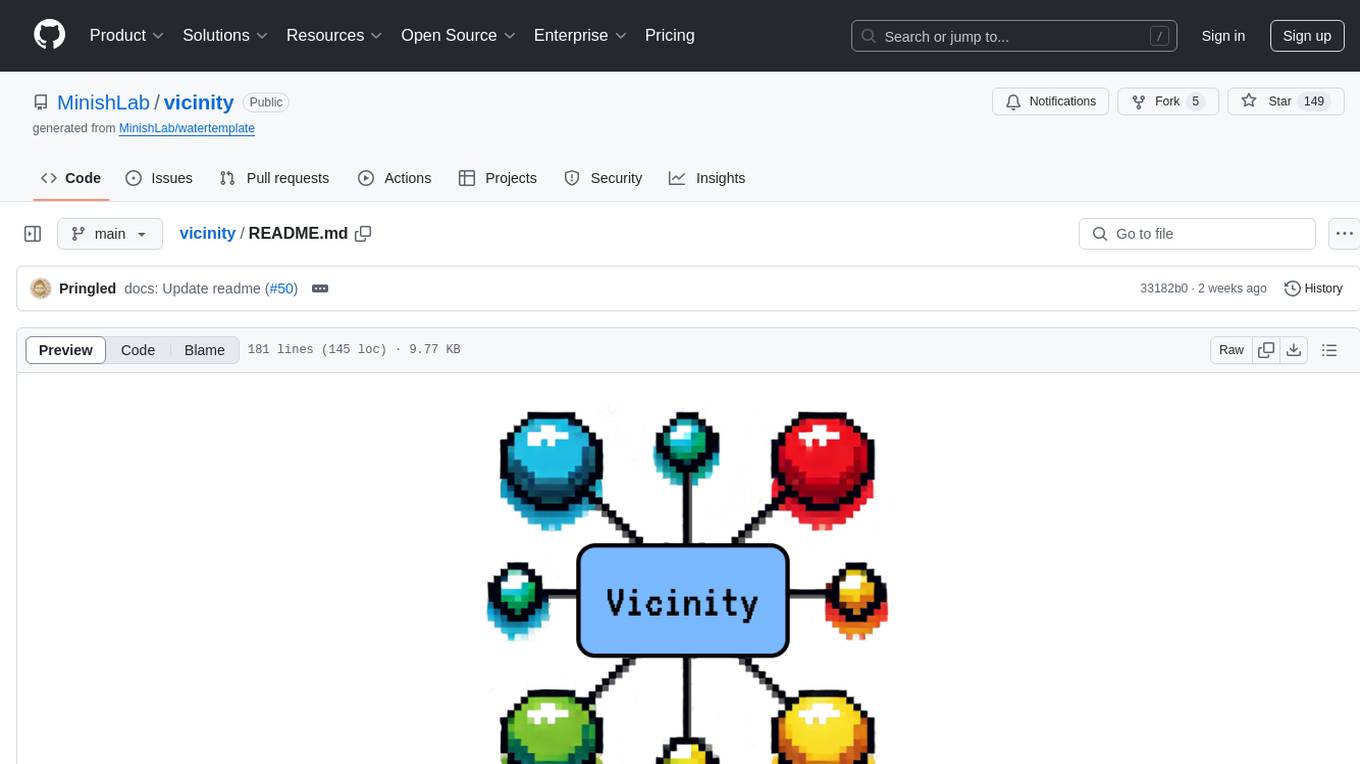
vicinity
Vicinity is a lightweight, low-dependency vector store that provides a unified interface for nearest neighbor search with support for different backends and evaluation. It simplifies the process of comparing and evaluating different nearest neighbors packages by offering a simple and intuitive API. Users can easily experiment with various indexing methods and distance metrics to choose the best one for their use case. Vicinity also allows for measuring performance metrics like queries per second and recall.
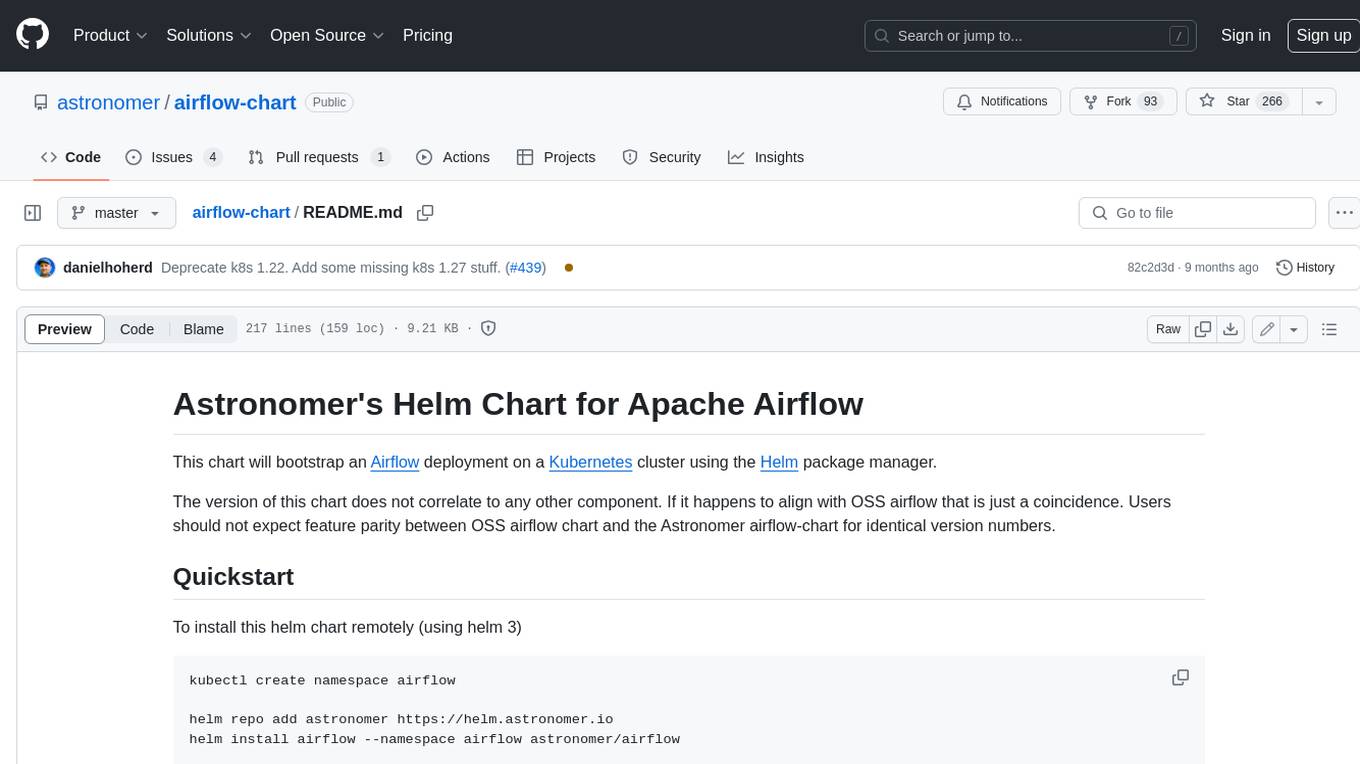
airflow-chart
This Helm chart bootstraps an Airflow deployment on a Kubernetes cluster using the Helm package manager. The version of this chart does not correlate to any other component. Users should not expect feature parity between OSS airflow chart and the Astronomer airflow-chart for identical version numbers. To install this helm chart remotely (using helm 3) kubectl create namespace airflow helm repo add astronomer https://helm.astronomer.io helm install airflow --namespace airflow astronomer/airflow To install this repository from source sh kubectl create namespace airflow helm install --namespace airflow . Prerequisites: Kubernetes 1.12+ Helm 3.6+ PV provisioner support in the underlying infrastructure Installing the Chart: sh helm install --name my-release . The command deploys Airflow on the Kubernetes cluster in the default configuration. The Parameters section lists the parameters that can be configured during installation. Upgrading the Chart: First, look at the updating documentation to identify any backwards-incompatible changes. To upgrade the chart with the release name `my-release`: sh helm upgrade --name my-release . Uninstalling the Chart: To uninstall/delete the `my-release` deployment: sh helm delete my-release The command removes all the Kubernetes components associated with the chart and deletes the release. Updating DAGs: Bake DAGs in Docker image The recommended way to update your DAGs with this chart is to build a new docker image with the latest code (`docker build -t my-company/airflow:8a0da78 .`), push it to an accessible registry (`docker push my-company/airflow:8a0da78`), then update the Airflow pods with that image: sh helm upgrade my-release . --set images.airflow.repository=my-company/airflow --set images.airflow.tag=8a0da78 Docker Images: The Airflow image that are referenced as the default values in this chart are generated from this repository: https://github.com/astronomer/ap-airflow. Other non-airflow images used in this chart are generated from this repository: https://github.com/astronomer/ap-vendor. Parameters: The complete list of parameters supported by the community chart can be found on the Parameteres Reference page, and can be set under the `airflow` key in this chart. The following tables lists the configurable parameters of the Astronomer chart and their default values. | Parameter | Description | Default | | :----------------------------- | :-------------------------------------------------------------------------------------------------------- | :---------------------------- | | `ingress.enabled` | Enable Kubernetes Ingress support | `false` | | `ingress.acme` | Add acme annotations to Ingress object | `false` | | `ingress.tlsSecretName` | Name of secret that contains a TLS secret | `~` | | `ingress.webserverAnnotations` | Annotations added to Webserver Ingress object | `{}` | | `ingress.flowerAnnotations` | Annotations added to Flower Ingress object | `{}` | | `ingress.baseDomain` | Base domain for VHOSTs | `~` | | `ingress.auth.enabled` | Enable auth with Astronomer Platform | `true` | | `extraObjects` | Extra K8s Objects to deploy (these are passed through `tpl`). More about Extra Objects. | `[]` | | `sccEnabled` | Enable security context constraints required for OpenShift | `false` | | `authSidecar.enabled` | Enable authSidecar | `false` | | `authSidecar.repository` | The image for the auth sidecar proxy | `nginxinc/nginx-unprivileged` | | `authSidecar.tag` | The image tag for the auth sidecar proxy | `stable` | | `authSidecar.pullPolicy` | The K8s pullPolicy for the the auth sidecar proxy image | `IfNotPresent` | | `authSidecar.port` | The port the auth sidecar exposes | `8084` | | `gitSyncRelay.enabled` | Enables git sync relay feature. | `False` | | `gitSyncRelay.repo.url` | Upstream URL to the git repo to clone. | `~` | | `gitSyncRelay.repo.branch` | Branch of the upstream git repo to checkout. | `main` | | `gitSyncRelay.repo.depth` | How many revisions to check out. Leave as default `1` except in dev where history is needed. | `1` | | `gitSyncRelay.repo.wait` | Seconds to wait before pulling from the upstream remote. | `60` | | `gitSyncRelay.repo.subPath` | Path to the dags directory within the git repository. | `~` | Specify each parameter using the `--set key=value[,key=value]` argument to `helm install`. For example, sh helm install --name my-release --set executor=CeleryExecutor --set enablePodLaunching=false . Walkthrough using kind: Install kind, and create a cluster We recommend testing with Kubernetes 1.25+, example: sh kind create cluster --image kindest/node:v1.25.11 Confirm it's up: sh kubectl cluster-info --context kind-kind Add Astronomer's Helm repo sh helm repo add astronomer https://helm.astronomer.io helm repo update Create namespace + install the chart sh kubectl create namespace airflow helm install airflow -n airflow astronomer/airflow It may take a few minutes. Confirm the pods are up: sh kubectl get pods --all-namespaces helm list -n airflow Run `kubectl port-forward svc/airflow-webserver 8080:8080 -n airflow` to port-forward the Airflow UI to http://localhost:8080/ to confirm Airflow is working. Login as _admin_ and password _admin_. Build a Docker image from your DAGs: 1. Start a project using astro-cli, which will generate a Dockerfile, and load your DAGs in. You can test locally before pushing to kind with `astro airflow start`. `sh mkdir my-airflow-project && cd my-airflow-project astro dev init` 2. Then build the image: `sh docker build -t my-dags:0.0.1 .` 3. Load the image into kind: `sh kind load docker-image my-dags:0.0.1` 4. Upgrade Helm deployment: sh helm upgrade airflow -n airflow --set images.airflow.repository=my-dags --set images.airflow.tag=0.0.1 astronomer/airflow Extra Objects: This chart can deploy extra Kubernetes objects (assuming the role used by Helm can manage them). For Astronomer Cloud and Enterprise, the role permissions can be found in the Commander role. yaml extraObjects: - apiVersion: batch/v1beta1 kind: CronJob metadata: name: "{{ .Release.Name }}-somejob" spec: schedule: "*/10 * * * *" concurrencyPolicy: Forbid jobTemplate: spec: template: spec: containers: - name: myjob image: ubuntu command: - echo args: - hello restartPolicy: OnFailure Contributing: Check out our contributing guide! License: Apache 2.0 with Commons Clause
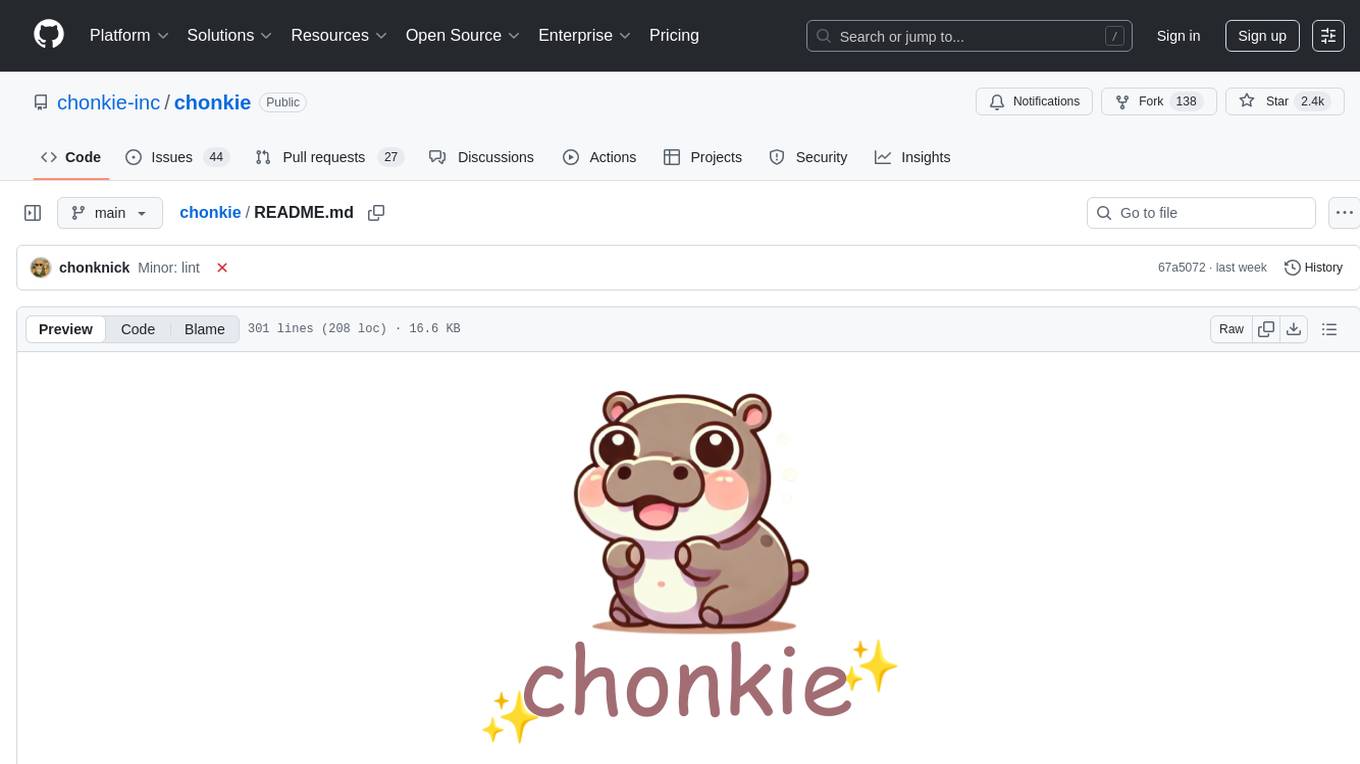
chonkie
Chonkie is a feature-rich, easy-to-use, fast, lightweight, and wide-support chunking library designed to efficiently split texts into chunks. It integrates with various tokenizers, embedding models, and APIs, supporting 56 languages and offering cloud-ready functionality. Chonkie provides a modular pipeline approach called CHOMP for text processing, chunking, post-processing, and exporting. With multiple chunkers, refineries, porters, and handshakes, Chonkie offers a comprehensive solution for text chunking needs. It includes 24+ integrations, 3+ LLM providers, 2+ refineries, 2+ porters, and 4+ vector database connections, making it a versatile tool for text processing and analysis.
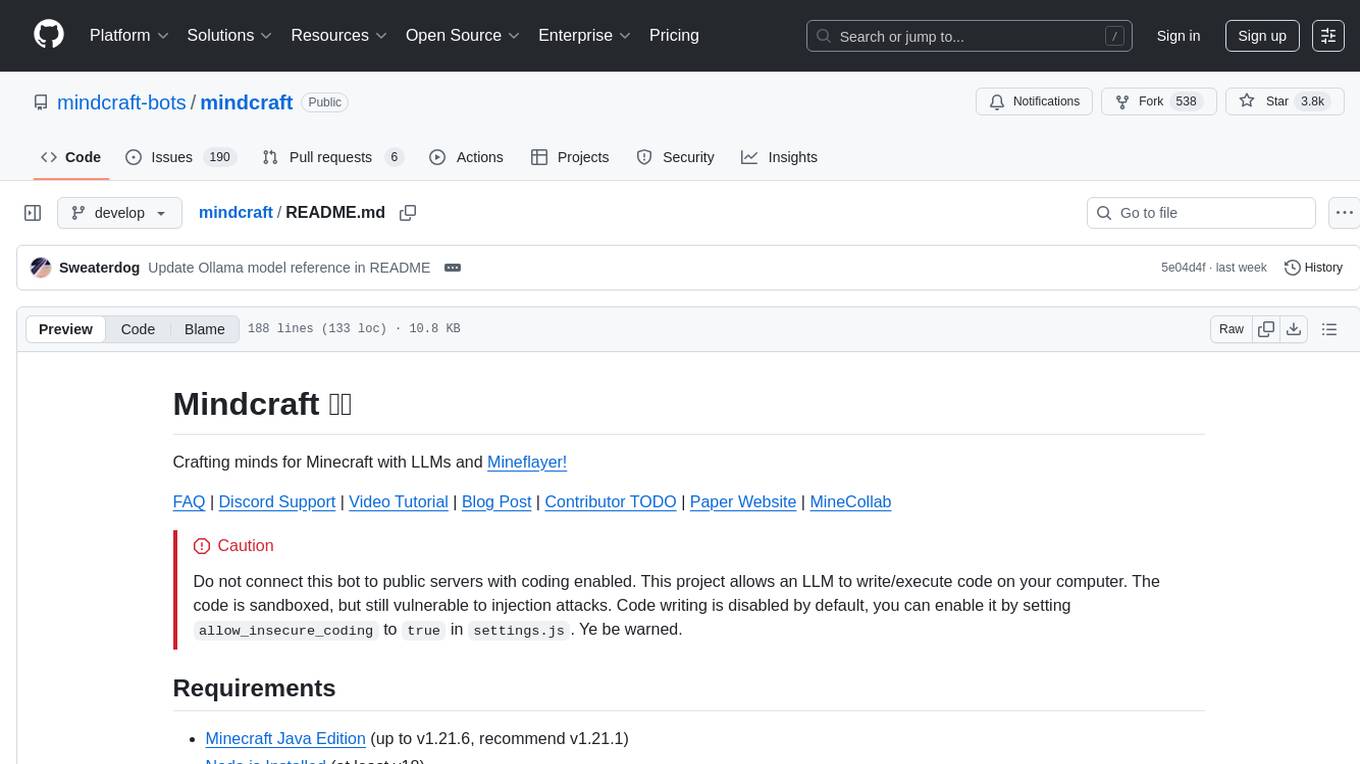
mindcraft
Mindcraft is a project that crafts minds for Minecraft using Large Language Models (LLMs) and Mineflayer. It allows an LLM to write and execute code on your computer, with code sandboxed but still vulnerable to injection attacks. The project requires Minecraft Java Edition, Node.js, and one of several API keys. Users can run tasks to acquire specific items or construct buildings, customize project details in settings.js, and connect to online servers with a Microsoft/Minecraft account. The project also supports Docker container deployment for running in a secure environment.
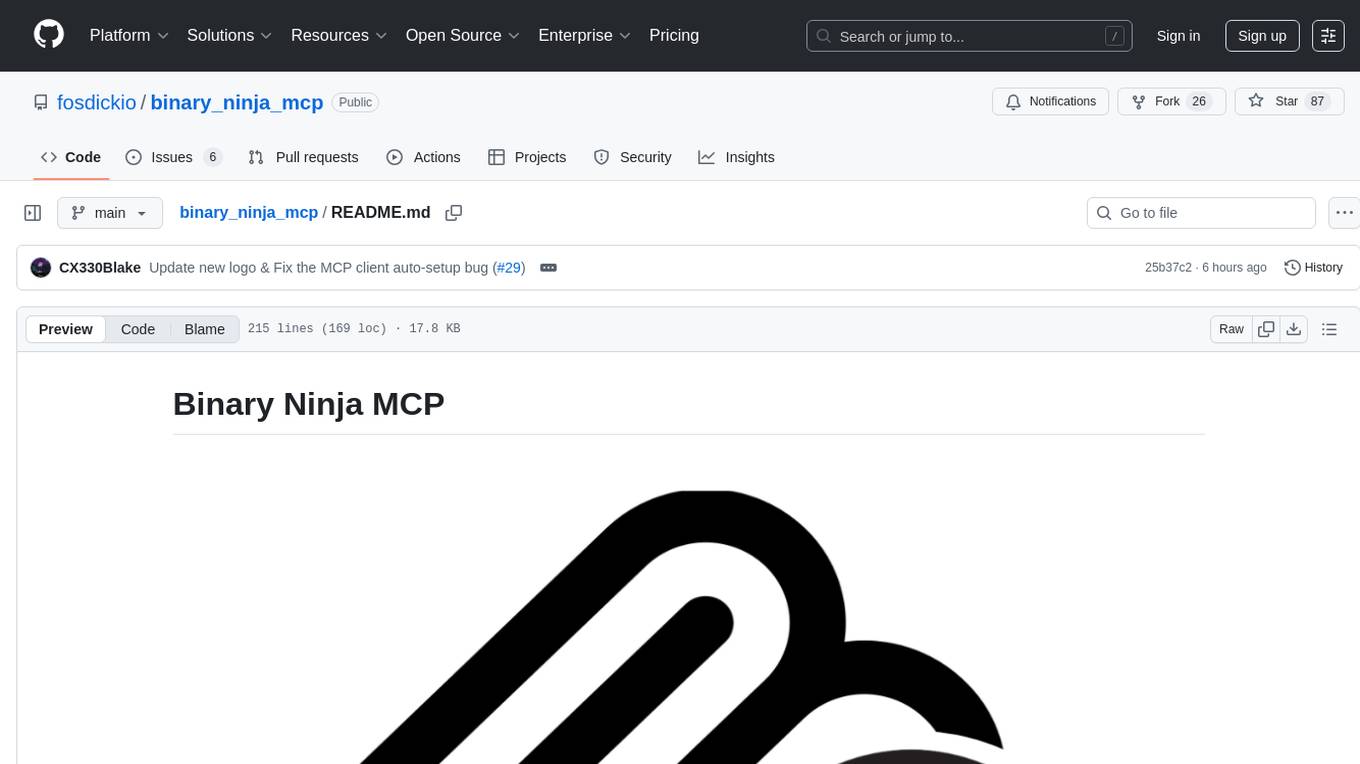
binary_ninja_mcp
This repository contains a Binary Ninja plugin, MCP server, and bridge that enables seamless integration of Binary Ninja's capabilities with your favorite LLM client. It provides real-time integration, AI assistance for reverse engineering, multi-binary support, and various MCP tools for tasks like decompiling functions, getting IL code, managing comments, renaming variables, and more.

BricksLLM
BricksLLM is a cloud native AI gateway written in Go. Currently, it provides native support for OpenAI, Anthropic, Azure OpenAI and vLLM. BricksLLM aims to provide enterprise level infrastructure that can power any LLM production use cases. Here are some use cases for BricksLLM: * Set LLM usage limits for users on different pricing tiers * Track LLM usage on a per user and per organization basis * Block or redact requests containing PIIs * Improve LLM reliability with failovers, retries and caching * Distribute API keys with rate limits and cost limits for internal development/production use cases * Distribute API keys with rate limits and cost limits for students
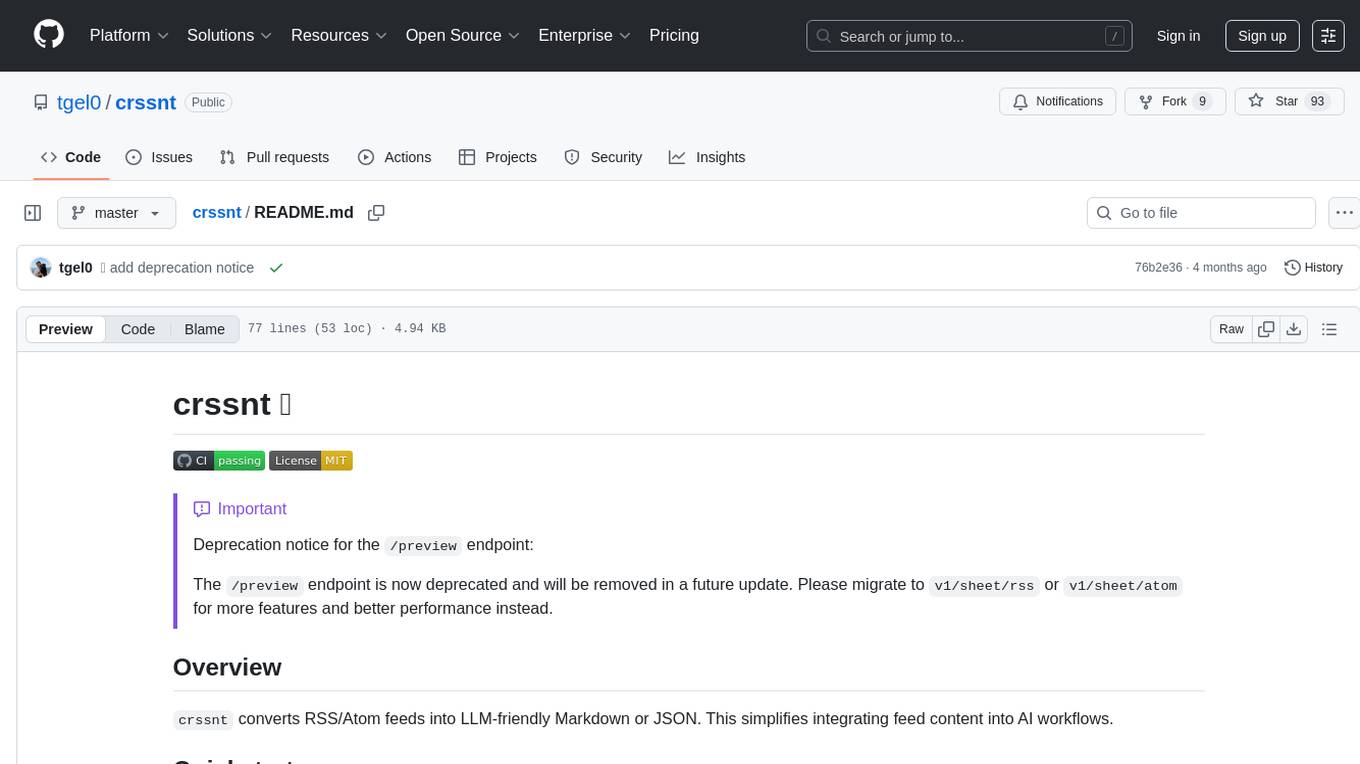
crssnt
crssnt is a tool that converts RSS/Atom feeds into LLM-friendly Markdown or JSON, simplifying integration of feed content into AI workflows. It supports LLM-optimized conversion, multiple output formats, feed aggregation, and Google Sheet support. Users can access various endpoints for feed conversion and Google Sheet processing, with query parameters for customization. The tool processes user-provided URLs transiently without storing feed data, and can be self-hosted as Firebase Cloud Functions. Contributions are welcome under the MIT License.
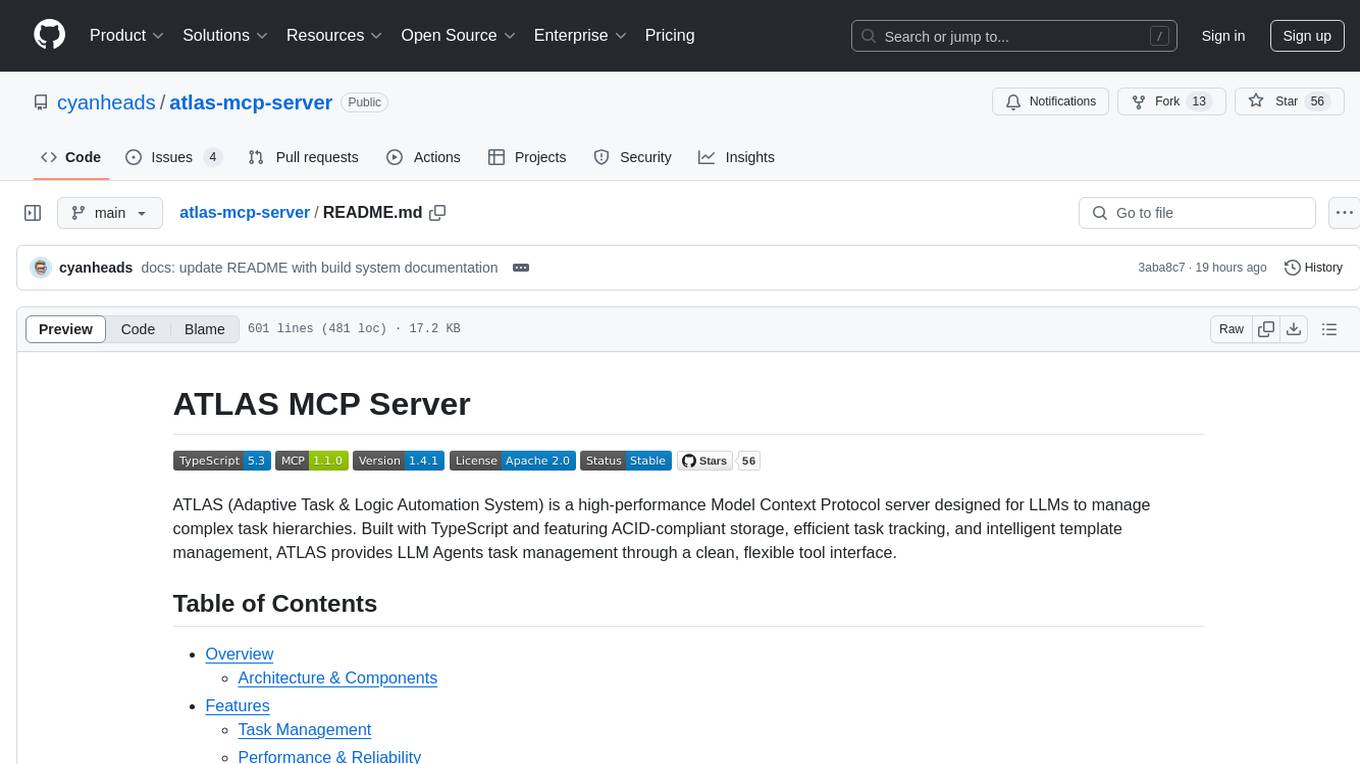
atlas-mcp-server
ATLAS (Adaptive Task & Logic Automation System) is a high-performance Model Context Protocol server designed for LLMs to manage complex task hierarchies. Built with TypeScript, it features ACID-compliant storage, efficient task tracking, and intelligent template management. ATLAS provides LLM Agents task management through a clean, flexible tool interface. The server implements the Model Context Protocol (MCP) for standardized communication between LLMs and external systems, offering hierarchical task organization, task state management, smart templates, enterprise features, and performance optimization.
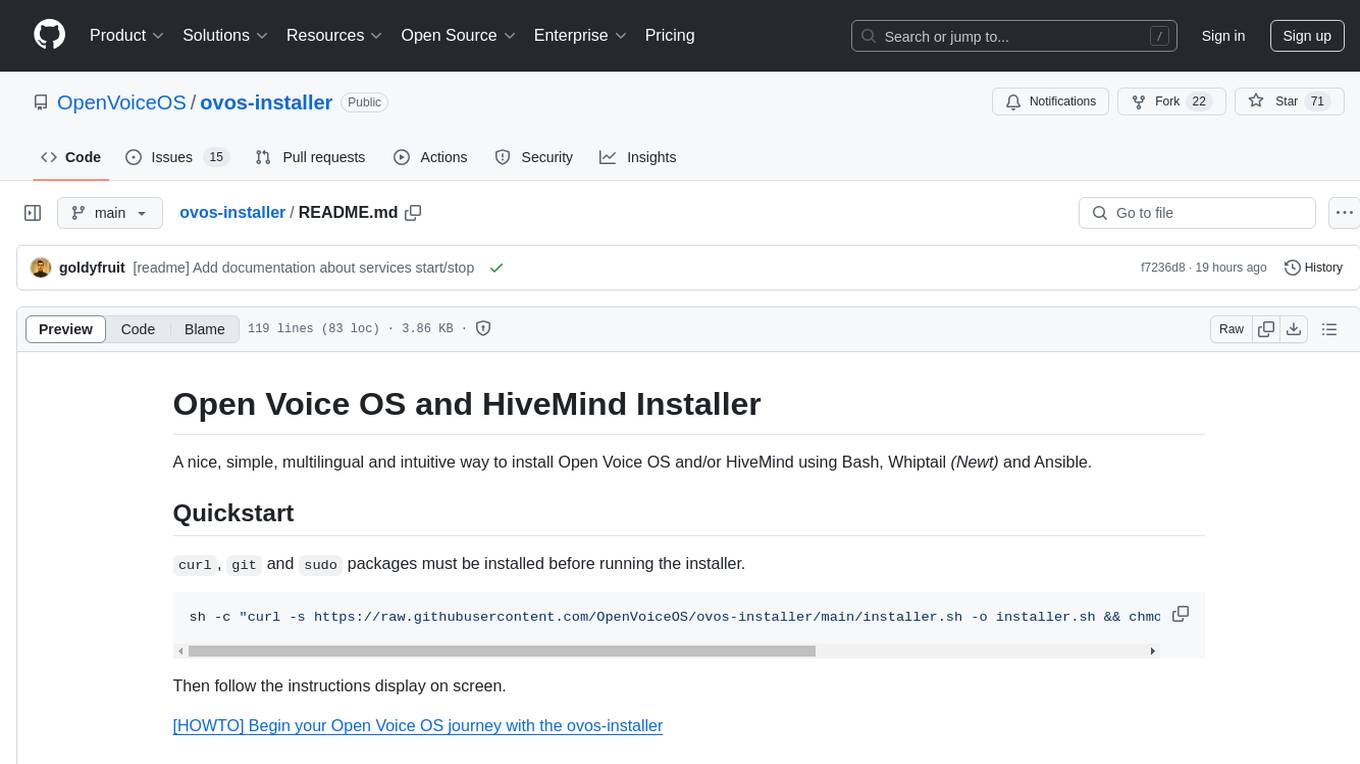
ovos-installer
The ovos-installer is a simple and multilingual tool designed to install Open Voice OS and HiveMind using Bash, Whiptail, and Ansible. It supports various Linux distributions and provides an automated installation process. Users can easily start and stop services, update their Open Voice OS instance, and uninstall the tool if needed. The installer also allows for non-interactive installation through scenario files. It offers a user-friendly way to set up Open Voice OS on different systems.
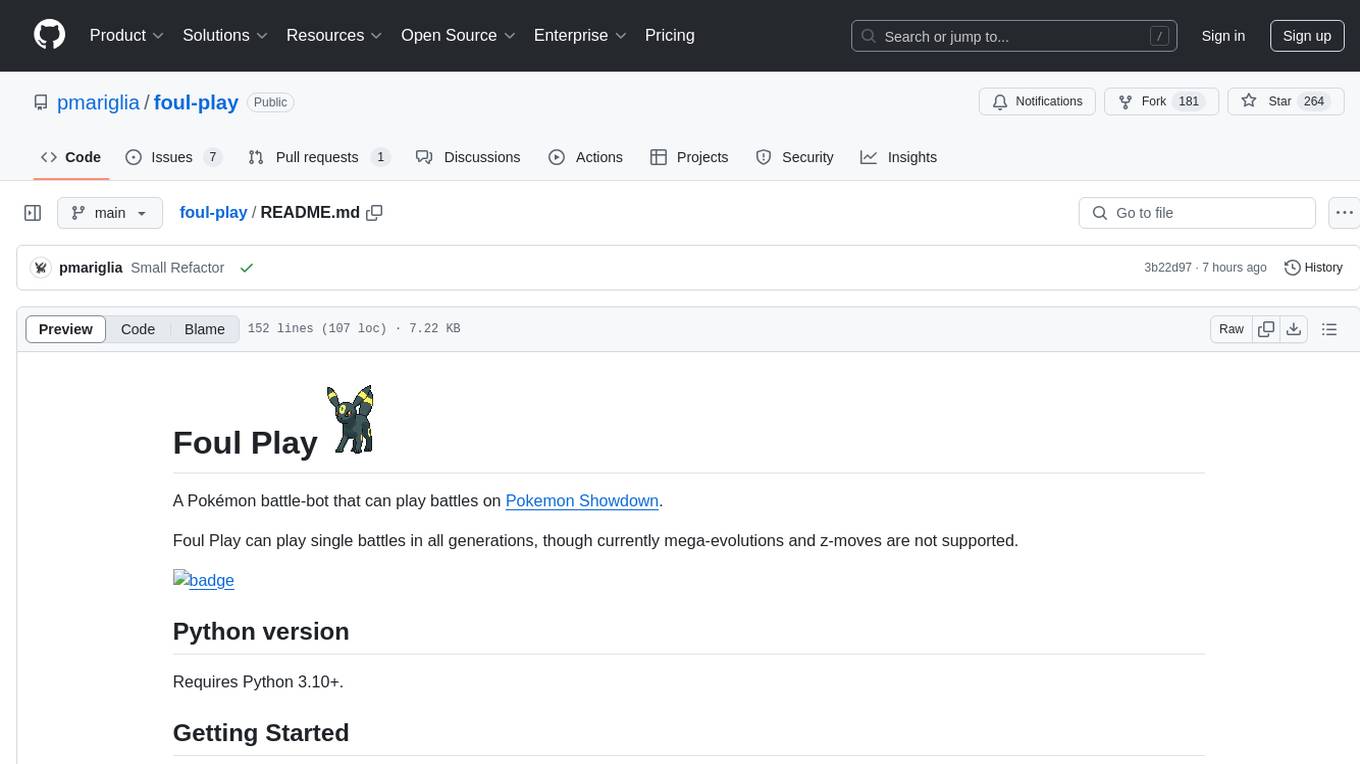
foul-play
Foul Play is a Pokémon battle-bot that can play single battles in all generations on Pokemon Showdown. It requires Python 3.10+. The bot uses environment variables for configuration and supports different game modes and battle strategies. Users can specify teams and choose between algorithms like Monte-Carlo Tree Search and Expectiminimax. Foul Play can be run locally or with Docker, and the engine used for battles must be built from source. The tool provides flexibility in gameplay and strategy for Pokémon battles.
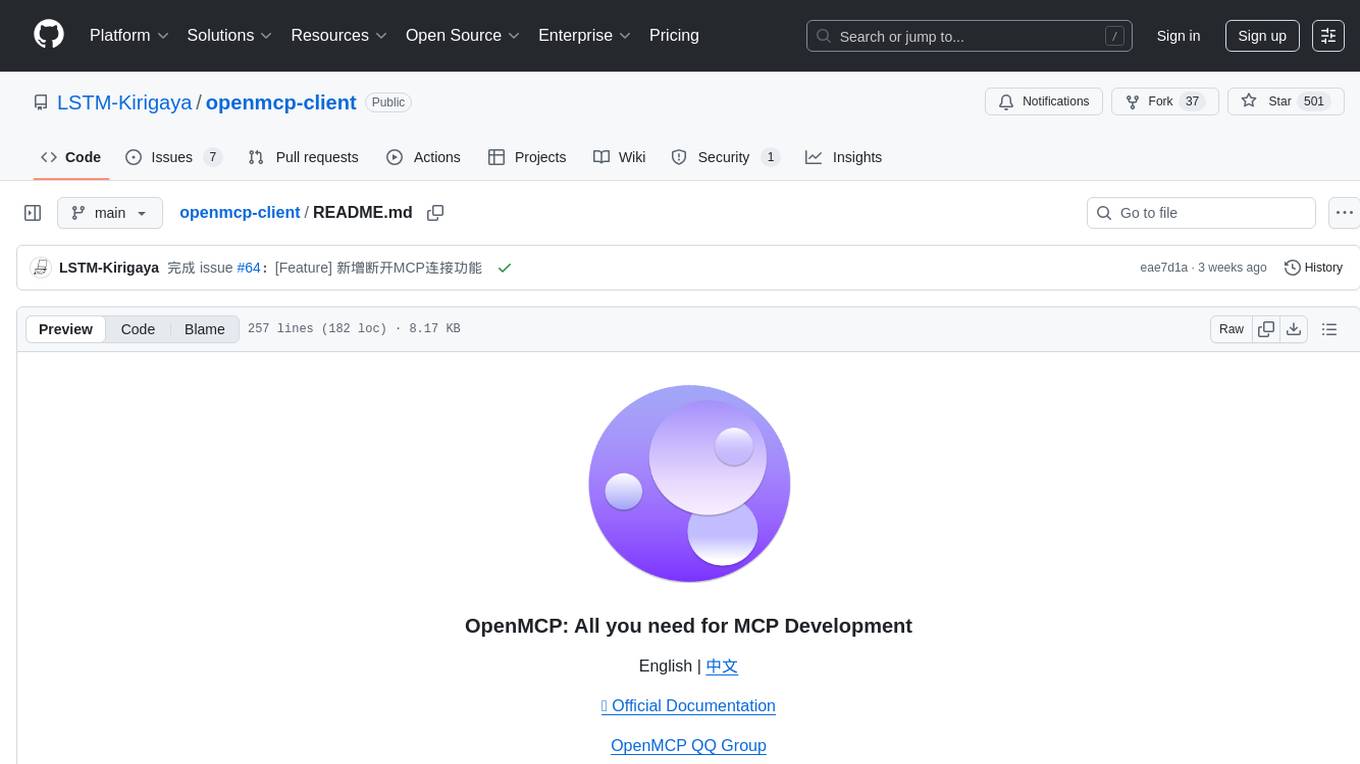
openmcp-client
OpenMCP is an integrated plugin for MCP server debugging in vscode/trae/cursor, combining development and testing functionalities. It includes tools for testing MCP resources, managing large model interactions, project-level management, and supports multiple large models. The openmcp-sdk allows for deploying MCP as an agent app with easy configuration and execution of tasks. The project follows a modular design allowing implementation in different modes on various platforms.
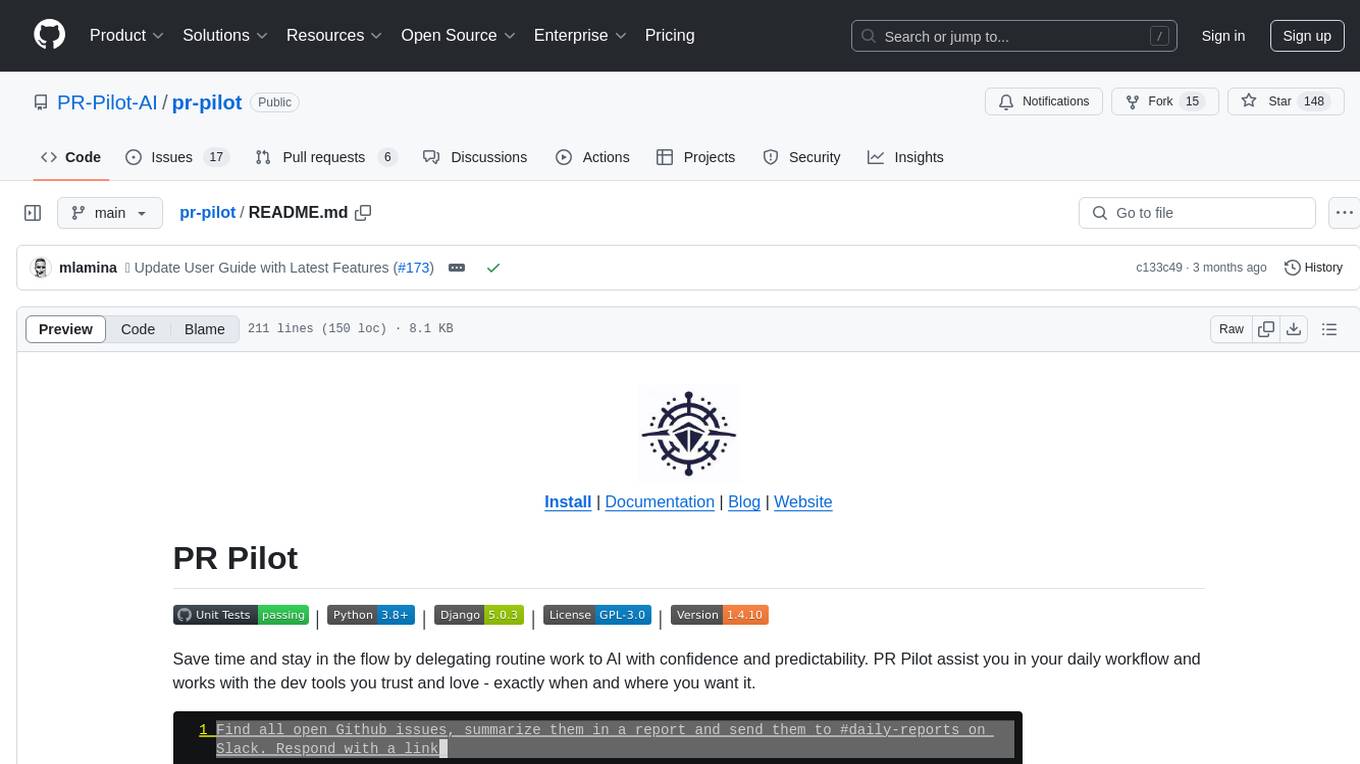
pr-pilot
PR Pilot is an AI-powered tool designed to assist users in their daily workflow by delegating routine work to AI with confidence and predictability. It integrates seamlessly with popular development tools and allows users to interact with it through a Command-Line Interface, Python SDK, REST API, and Smart Workflows. Users can automate tasks such as generating PR titles and descriptions, summarizing and posting issues, and formatting README files. The tool aims to save time and enhance productivity by providing AI-powered solutions for common development tasks.
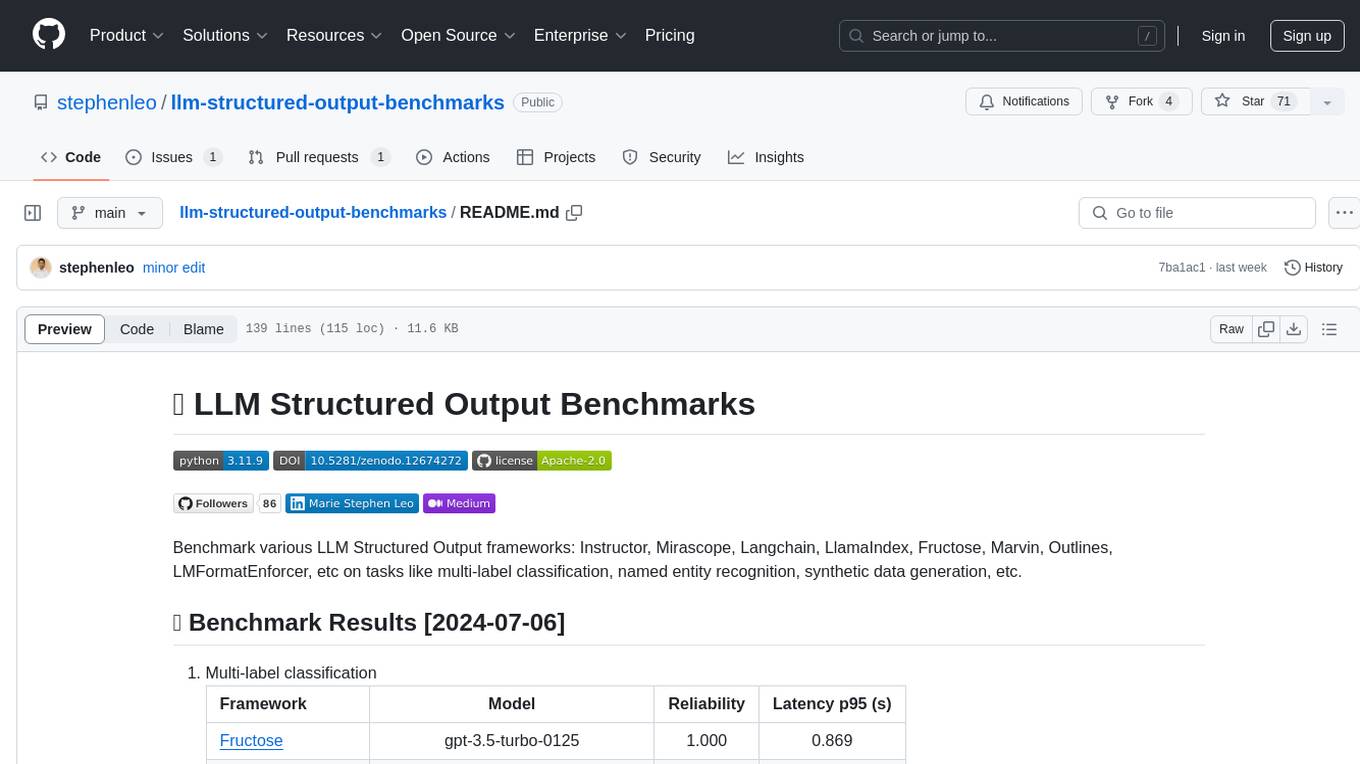
llm-structured-output-benchmarks
Benchmark various LLM Structured Output frameworks like Instructor, Mirascope, Langchain, LlamaIndex, Fructose, Marvin, Outlines, LMFormatEnforcer, etc on tasks like multi-label classification, named entity recognition, synthetic data generation. The tool provides benchmark results, methodology, instructions to run the benchmark, add new data, and add a new framework. It also includes a roadmap for framework-related tasks, contribution guidelines, citation information, and feedback request.
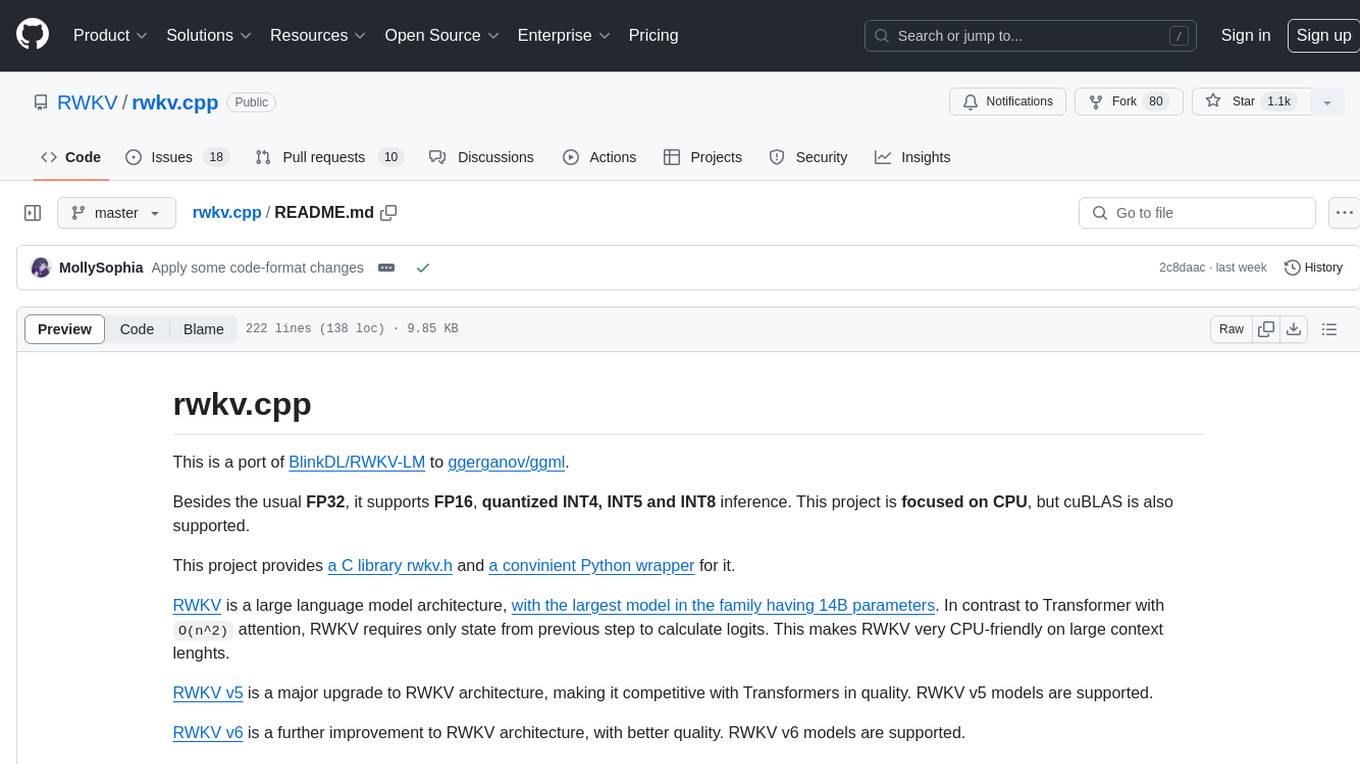
rwkv.cpp
rwkv.cpp is a port of BlinkDL/RWKV-LM to ggerganov/ggml, supporting FP32, FP16, and quantized INT4, INT5, and INT8 inference. It focuses on CPU but also supports cuBLAS. The project provides a C library rwkv.h and a Python wrapper. RWKV is a large language model architecture with models like RWKV v5 and v6. It requires only state from the previous step for calculations, making it CPU-friendly on large context lengths. Users are advised to test all available formats for perplexity and latency on a representative dataset before serious use.
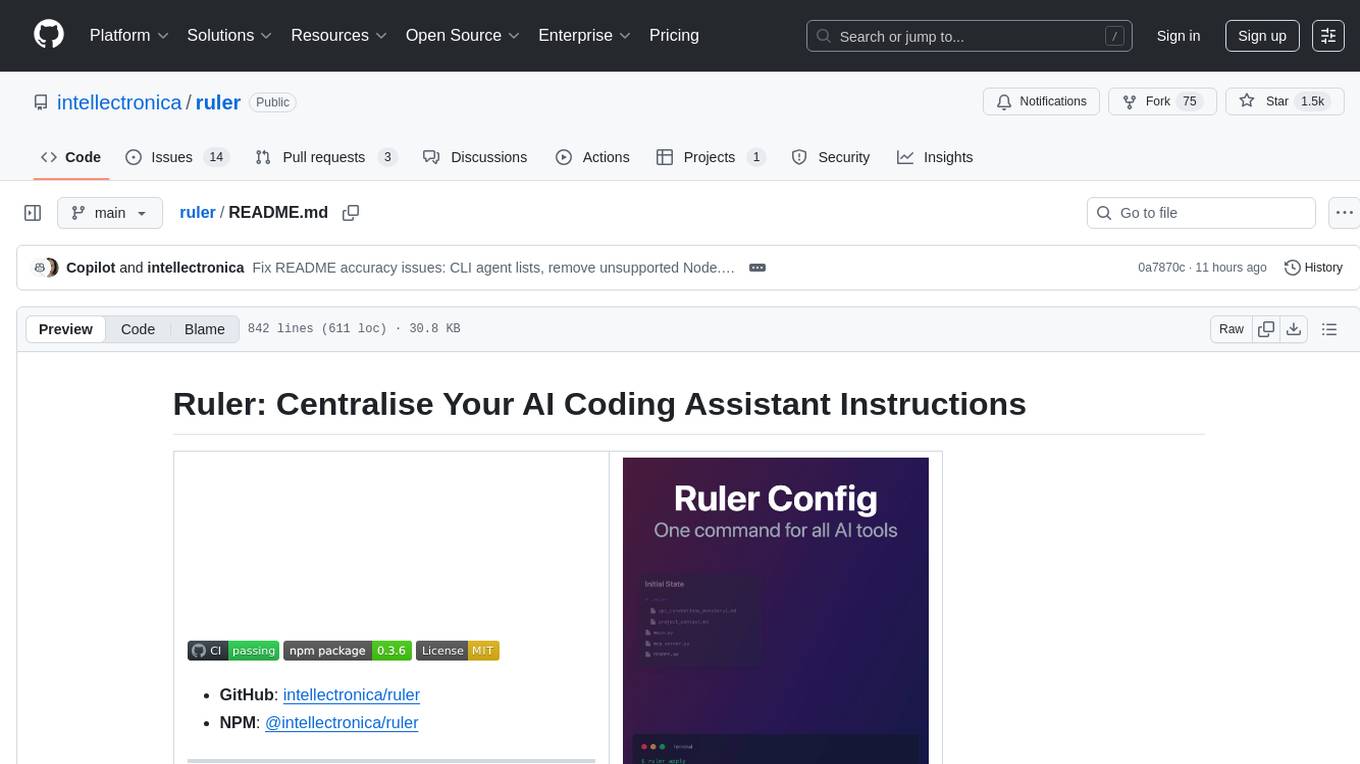
ruler
Ruler is a tool designed to centralize AI coding assistant instructions, providing a single source of truth for managing instructions across multiple AI coding tools. It helps in avoiding inconsistent guidance, duplicated effort, context drift, onboarding friction, and complex project structures by automatically distributing instructions to the right configuration files. With support for nested rule loading, Ruler can handle complex project structures with context-specific instructions for different components. It offers features like centralised rule management, nested rule loading, automatic distribution, targeted agent configuration, MCP server propagation, .gitignore automation, and a simple CLI for easy configuration management.
For similar tasks

worker-vllm
The worker-vLLM repository provides a serverless endpoint for deploying OpenAI-compatible vLLM models with blazing-fast performance. It supports deploying various model architectures, such as Aquila, Baichuan, BLOOM, ChatGLM, Command-R, DBRX, DeciLM, Falcon, Gemma, GPT-2, GPT BigCode, GPT-J, GPT-NeoX, InternLM, Jais, LLaMA, MiniCPM, Mistral, Mixtral, MPT, OLMo, OPT, Orion, Phi, Phi-3, Qwen, Qwen2, Qwen2MoE, StableLM, Starcoder2, Xverse, and Yi. Users can deploy models using pre-built Docker images or build custom images with specified arguments. The repository also supports OpenAI compatibility for chat completions, completions, and models, with customizable input parameters. Users can modify their OpenAI codebase to use the deployed vLLM worker and access a list of available models for deployment.

ai-on-gke
This repository contains assets related to AI/ML workloads on Google Kubernetes Engine (GKE). Run optimized AI/ML workloads with Google Kubernetes Engine (GKE) platform orchestration capabilities. A robust AI/ML platform considers the following layers: Infrastructure orchestration that support GPUs and TPUs for training and serving workloads at scale Flexible integration with distributed computing and data processing frameworks Support for multiple teams on the same infrastructure to maximize utilization of resources
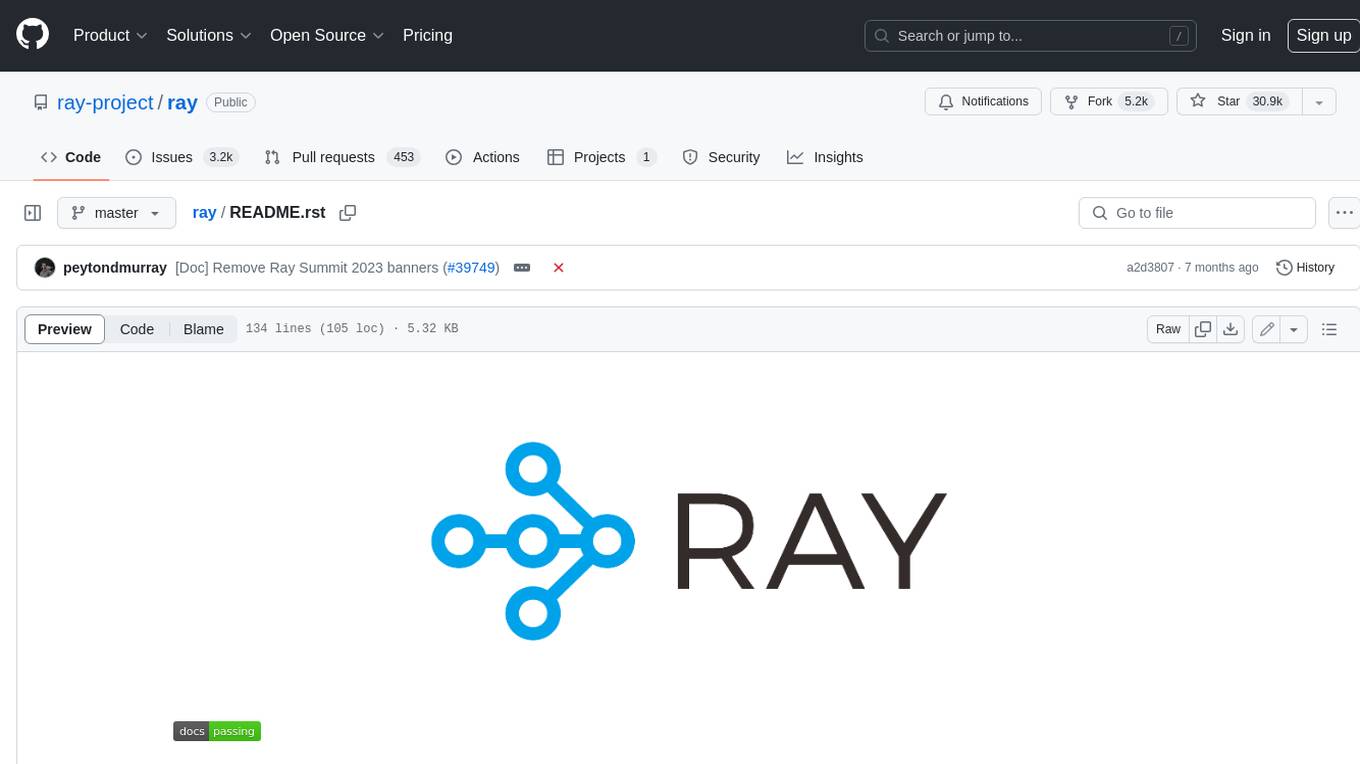
ray
Ray is a unified framework for scaling AI and Python applications. It consists of a core distributed runtime and a set of AI libraries for simplifying ML compute, including Data, Train, Tune, RLlib, and Serve. Ray runs on any machine, cluster, cloud provider, and Kubernetes, and features a growing ecosystem of community integrations. With Ray, you can seamlessly scale the same code from a laptop to a cluster, making it easy to meet the compute-intensive demands of modern ML workloads.

labelbox-python
Labelbox is a data-centric AI platform for enterprises to develop, optimize, and use AI to solve problems and power new products and services. Enterprises use Labelbox to curate data, generate high-quality human feedback data for computer vision and LLMs, evaluate model performance, and automate tasks by combining AI and human-centric workflows. The academic & research community uses Labelbox for cutting-edge AI research.
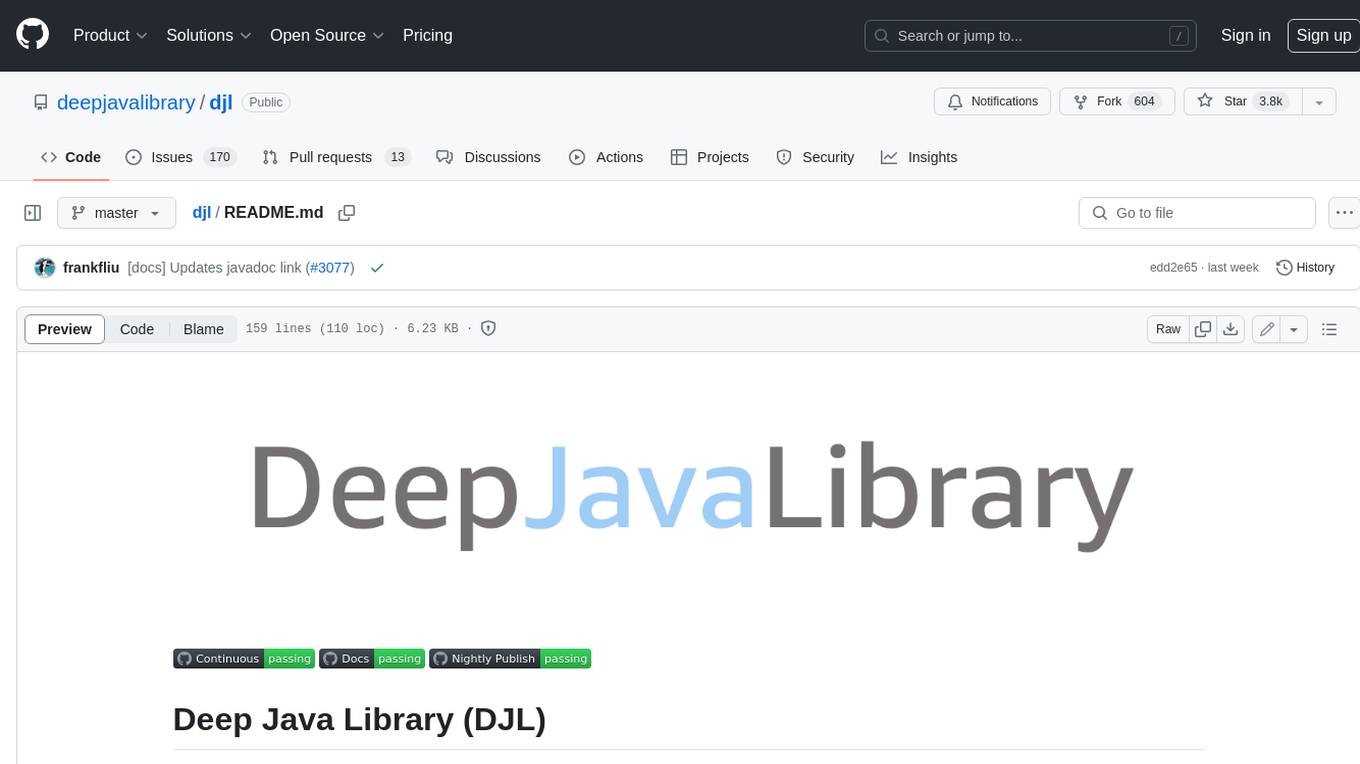
djl
Deep Java Library (DJL) is an open-source, high-level, engine-agnostic Java framework for deep learning. It is designed to be easy to get started with and simple to use for Java developers. DJL provides a native Java development experience and allows users to integrate machine learning and deep learning models with their Java applications. The framework is deep learning engine agnostic, enabling users to switch engines at any point for optimal performance. DJL's ergonomic API interface guides users with best practices to accomplish deep learning tasks, such as running inference and training neural networks.
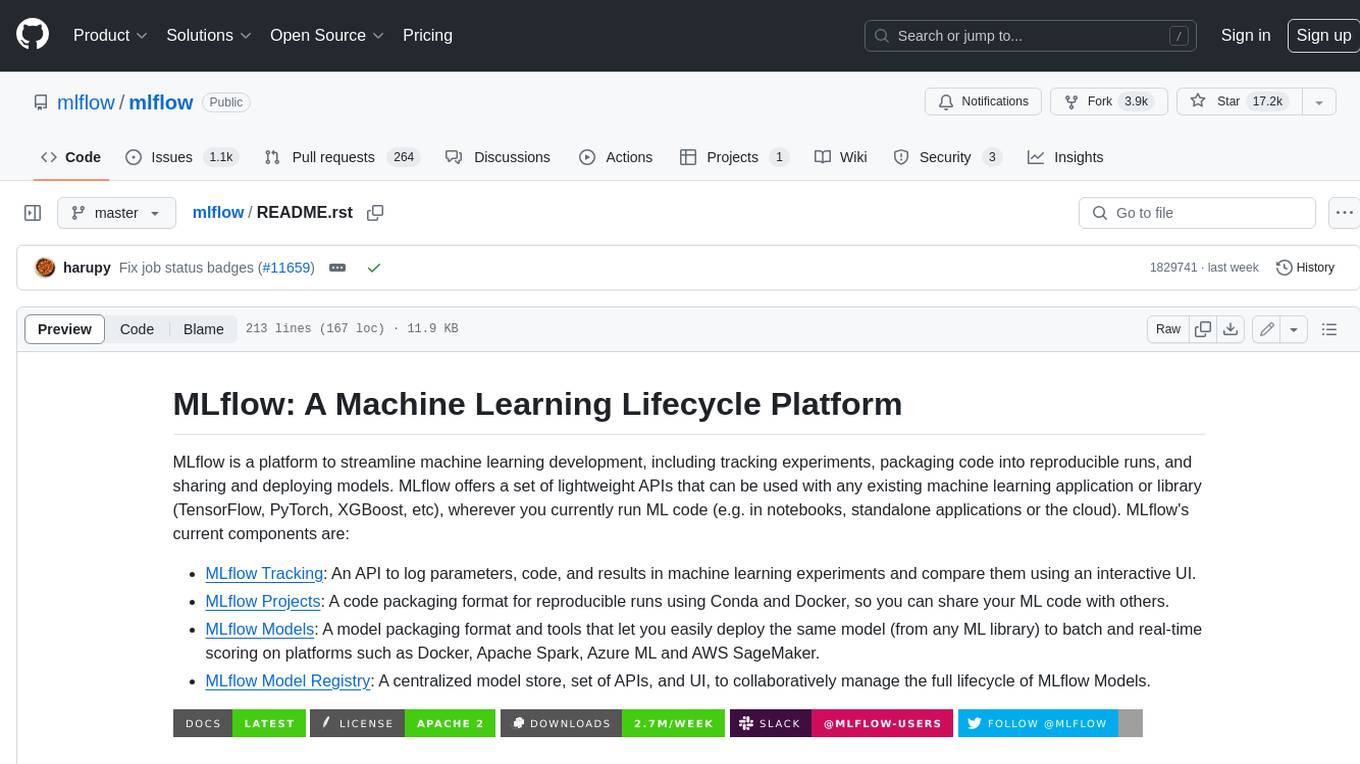
mlflow
MLflow is a platform to streamline machine learning development, including tracking experiments, packaging code into reproducible runs, and sharing and deploying models. MLflow offers a set of lightweight APIs that can be used with any existing machine learning application or library (TensorFlow, PyTorch, XGBoost, etc), wherever you currently run ML code (e.g. in notebooks, standalone applications or the cloud). MLflow's current components are:
* `MLflow Tracking

tt-metal
TT-NN is a python & C++ Neural Network OP library. It provides a low-level programming model, TT-Metalium, enabling kernel development for Tenstorrent hardware.
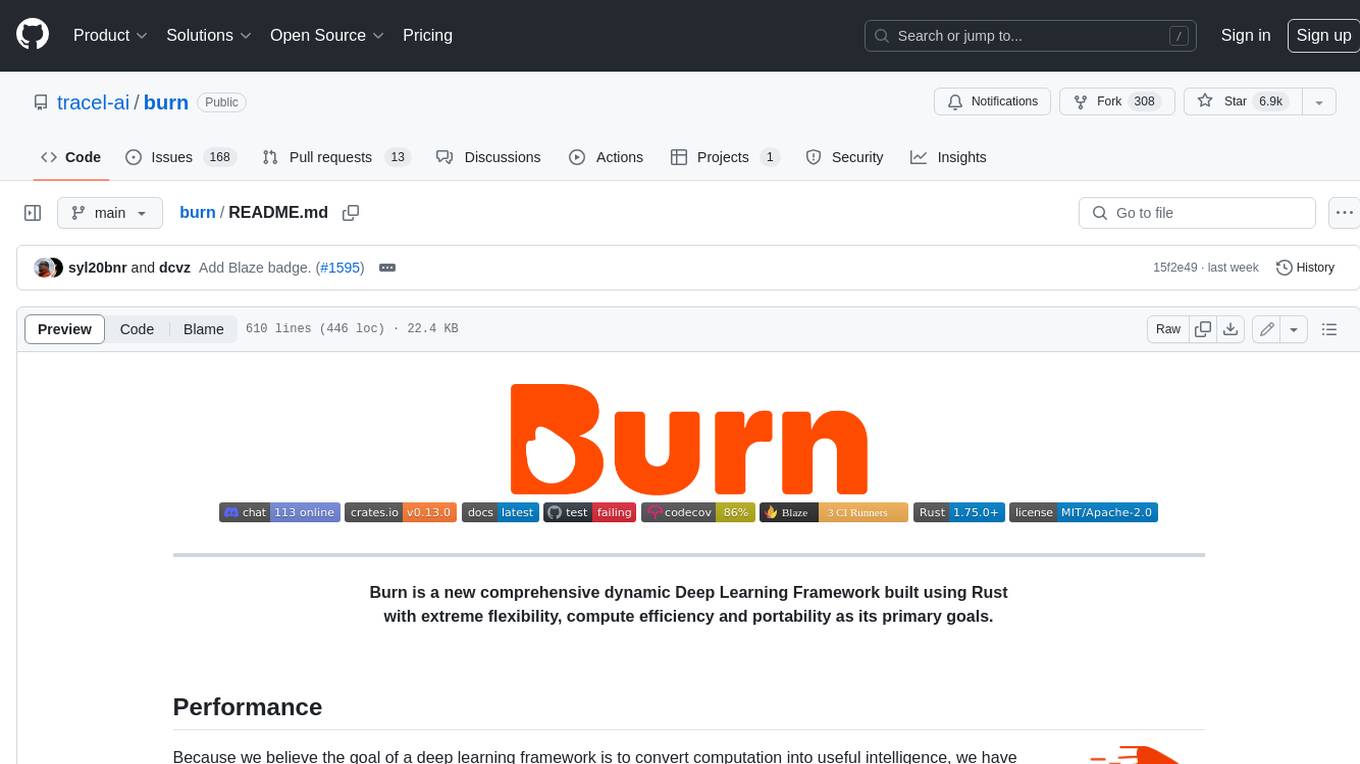
burn
Burn is a new comprehensive dynamic Deep Learning Framework built using Rust with extreme flexibility, compute efficiency and portability as its primary goals.
For similar jobs

weave
Weave is a toolkit for developing Generative AI applications, built by Weights & Biases. With Weave, you can log and debug language model inputs, outputs, and traces; build rigorous, apples-to-apples evaluations for language model use cases; and organize all the information generated across the LLM workflow, from experimentation to evaluations to production. Weave aims to bring rigor, best-practices, and composability to the inherently experimental process of developing Generative AI software, without introducing cognitive overhead.

LLMStack
LLMStack is a no-code platform for building generative AI agents, workflows, and chatbots. It allows users to connect their own data, internal tools, and GPT-powered models without any coding experience. LLMStack can be deployed to the cloud or on-premise and can be accessed via HTTP API or triggered from Slack or Discord.

VisionCraft
The VisionCraft API is a free API for using over 100 different AI models. From images to sound.

kaito
Kaito is an operator that automates the AI/ML inference model deployment in a Kubernetes cluster. It manages large model files using container images, avoids tuning deployment parameters to fit GPU hardware by providing preset configurations, auto-provisions GPU nodes based on model requirements, and hosts large model images in the public Microsoft Container Registry (MCR) if the license allows. Using Kaito, the workflow of onboarding large AI inference models in Kubernetes is largely simplified.

PyRIT
PyRIT is an open access automation framework designed to empower security professionals and ML engineers to red team foundation models and their applications. It automates AI Red Teaming tasks to allow operators to focus on more complicated and time-consuming tasks and can also identify security harms such as misuse (e.g., malware generation, jailbreaking), and privacy harms (e.g., identity theft). The goal is to allow researchers to have a baseline of how well their model and entire inference pipeline is doing against different harm categories and to be able to compare that baseline to future iterations of their model. This allows them to have empirical data on how well their model is doing today, and detect any degradation of performance based on future improvements.

tabby
Tabby is a self-hosted AI coding assistant, offering an open-source and on-premises alternative to GitHub Copilot. It boasts several key features: * Self-contained, with no need for a DBMS or cloud service. * OpenAPI interface, easy to integrate with existing infrastructure (e.g Cloud IDE). * Supports consumer-grade GPUs.

spear
SPEAR (Simulator for Photorealistic Embodied AI Research) is a powerful tool for training embodied agents. It features 300 unique virtual indoor environments with 2,566 unique rooms and 17,234 unique objects that can be manipulated individually. Each environment is designed by a professional artist and features detailed geometry, photorealistic materials, and a unique floor plan and object layout. SPEAR is implemented as Unreal Engine assets and provides an OpenAI Gym interface for interacting with the environments via Python.

Magick
Magick is a groundbreaking visual AIDE (Artificial Intelligence Development Environment) for no-code data pipelines and multimodal agents. Magick can connect to other services and comes with nodes and templates well-suited for intelligent agents, chatbots, complex reasoning systems and realistic characters.
